Naples and Sorrento in Italy offer a unique blend of art, history, food, and breathtaking landscapes. From street food to ancient ruins like Pompeii, this region has something for every kind of traveler. Explore Naples' culinary delights, scenic views on the Amalfi Coast, iconic towns, and luxury villas, as well as visit Capri's famous Blue Grotto and experience the magic of this Italian destination.
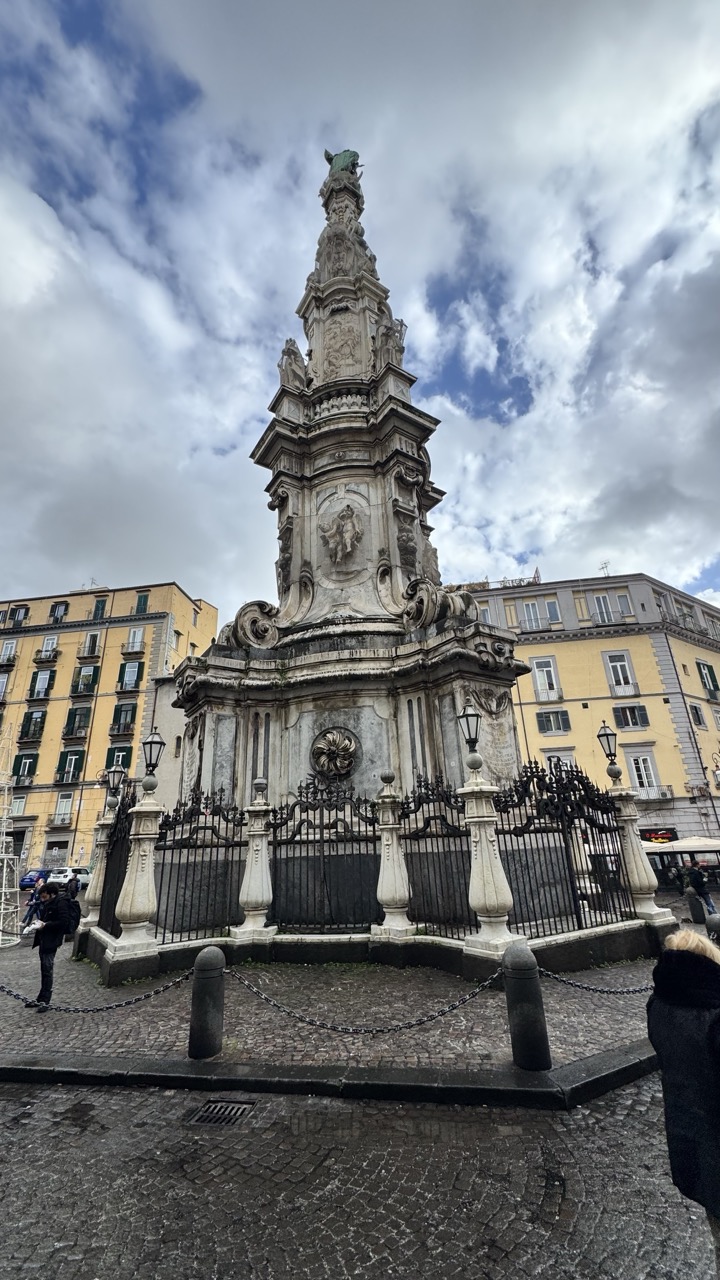

Monumental Grey Day
Rating: 8/10 (The monument itself is undeniably impressive)
Ah, behold the imposing Spire of... well, it's a big, fancy column thingy smack in the middle of a city square. Looks like it's carved within an inch of its life, topped with a figure reaching for the heavens (or perhaps just complaining about the weather). Surrounded by a rather sturdy fence, which is probably wise given the scale of the thing, preventing rogue pigeons or overly enthusiastic tourists from getting too close. The cobblestone ground is slick, suggesting either a recent shower or perhaps the city's eternal battle against spilled gelato. A few hardy souls are navigating the damp terrain, adding a touch of scale to this monumental scene. In the background, classic Italianate buildings with rows of windows provide a colorful, if slightly muted, backdrop.
From a photographic standpoint, we've got a classic low-angle shot emphasizing the sheer verticality and grandeur of the monument. It's centered, which is simple and effective, but maybe a touch predictable – could have been fun to play with the edges a bit, but who wants to miss out on *any* of that stone lace? The lighting is brought to you by "Overcast Skies Inc.," providing flat, shadowless illumination that's great for detail but makes everything feel a bit... grey. The color palette is dominated by the stone and the sky, punctuated by the hopeful yellow of the background building trying its best to brighten things up. It's a solid documentary style shot, capturing the essence of the location, even if the weather isn't exactly postcard perfect. Still, there's a certain moody drama to it, like the monument is pondering existential questions about drizzle.
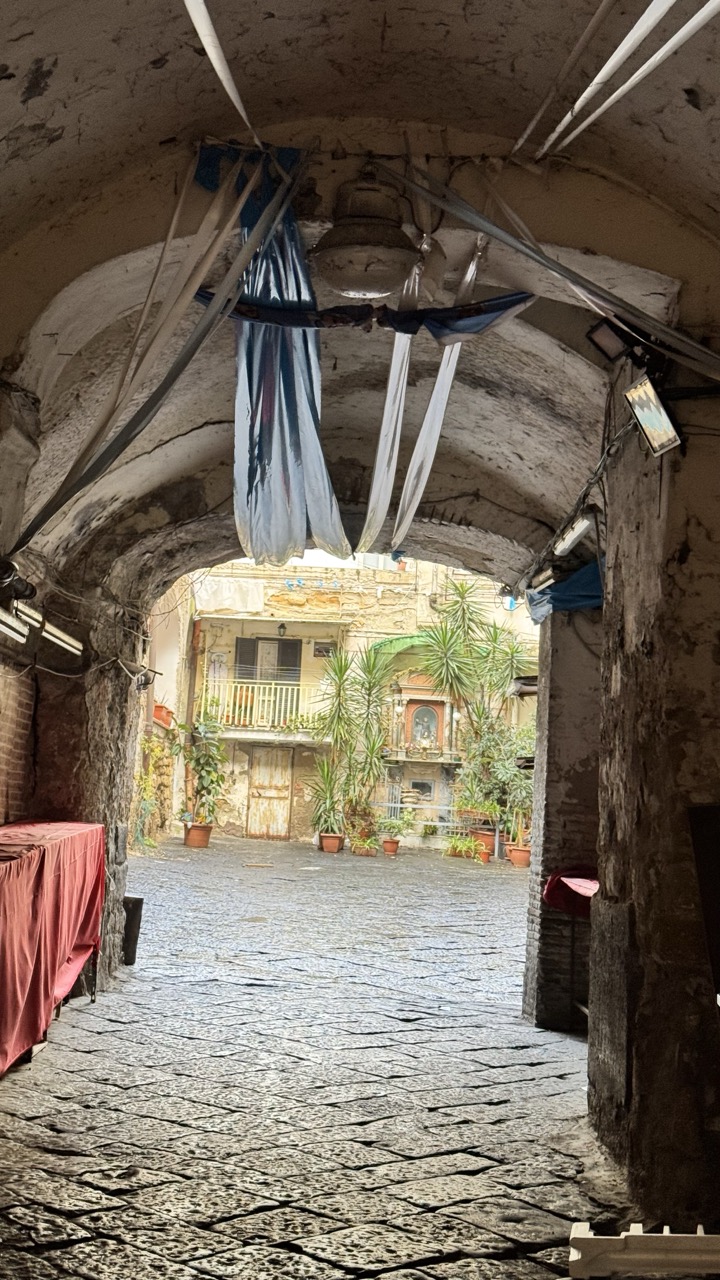

Peeking Through the Archway into a Courtyard Oasis
Rating: Subject: 7/10
Step right up, folks! Or rather, peek through this glorious, slightly dilapidated archway into what seems to be a hidden urban oasis. What's happening here? We're getting a tantalizing glimpse into a private courtyard, bursting with potted plants that are clearly thriving despite the surrounding decay. The mood is one of discovered charm, a secret garden vibe nestled within ancient city walls. It feels authentically lived-in, a place where laundry might hang just out of frame and secrets are whispered between neighbors. The foreground is dominated by a rough stone archway, draped with some rather festive, if slightly random, metallic and white fabric decorations that add a touch of whimsical chaos overhead, alongside some more practical lighting fixtures. On the left, a flash of red fabric hints at a market stall or perhaps a temporary setup, adding another layer of mystery to this intriguing scene.
From a photography standpoint, the composition is quite effective, using the archway as a natural frame to draw the viewer's eye into the sunlit courtyard beyond. This use of negative space creates depth, although the shadows in the archway are quite deep, almost losing some textural detail on the walls – maybe a touch more exposure or fill light next time? The lighting contrast between the dark passage and the brighter courtyard is strong and dramatic. The color palette is wonderfully earthy and natural, with the vibrant greens of the plants providing a welcome contrast to the weathered stone and plaster. The detailed cobblestone ground in the foreground is a fantastic textural element, though slightly bright. The subject matter itself is rich with detail, from the crumbling balcony and peeling paint to the small religious shrine visible in the background, all telling a story of time and resilience. It's a great example of capturing the authentic character of a place, even with its imperfections, embracing a candid, slightly gritty urban style.
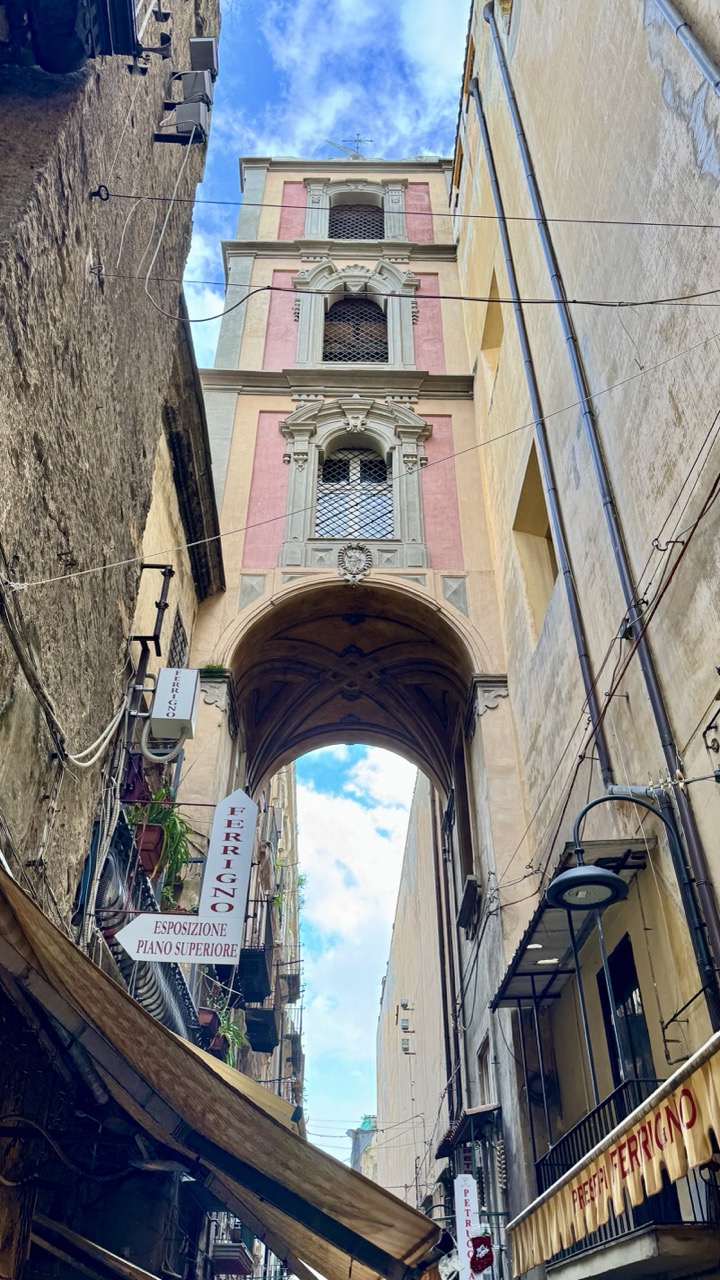

Glimpse Through the Arch
Rating: 8/10
Welcome to the urban canyon, where buildings hug so tightly you can almost high-five the person across the street! This photo perfectly captures that classic European alleyway feel, leading your eye through a grand archway that feels like a secret passage to... well, probably just another street, but one with a really impressive tower overhead. The subject here is the delightful claustrophobia of a narrow street opening up into architectural splendor, rating a solid 8/10 for its transportive qualities. What's happening is simply a moment in time, a pedestrian's view upwards, framed by centuries of history and perhaps a few modern conveniences like strategically placed air conditioning units. The mood is one of discovery and historical charm, a feeling of being immersed in the dense texture of an old city where every turn promises a new visual treat (or just another sign advertising something interesting).
From a photography standpoint, the vertical composition is spot on, emphasizing the height of the buildings and the looming presence of the tower, creating a wonderful sense of scale against the narrow passage below. The lighting, while a bit diffuse, brings out the warm, faded colors of the stucco and the more vibrant pink accents on the tower, making the scene pop against the blue sky peeking through the arch. Notice the lovely archway vaulting – it's a compositional win, framing the sky like a living painting. The visible details like the awnings, the hanging signs (advertising, perhaps, financial services or musical instruments?), and the chaotic web of wires add layers of authenticity and life to the scene. It’s a great example of how street photography captures the character of a place, messy bits and all, making you feel like you're right there, maybe wondering if "PIANO SUPERIORE" means they sell pianos upstairs or just have a better view from the top floor.
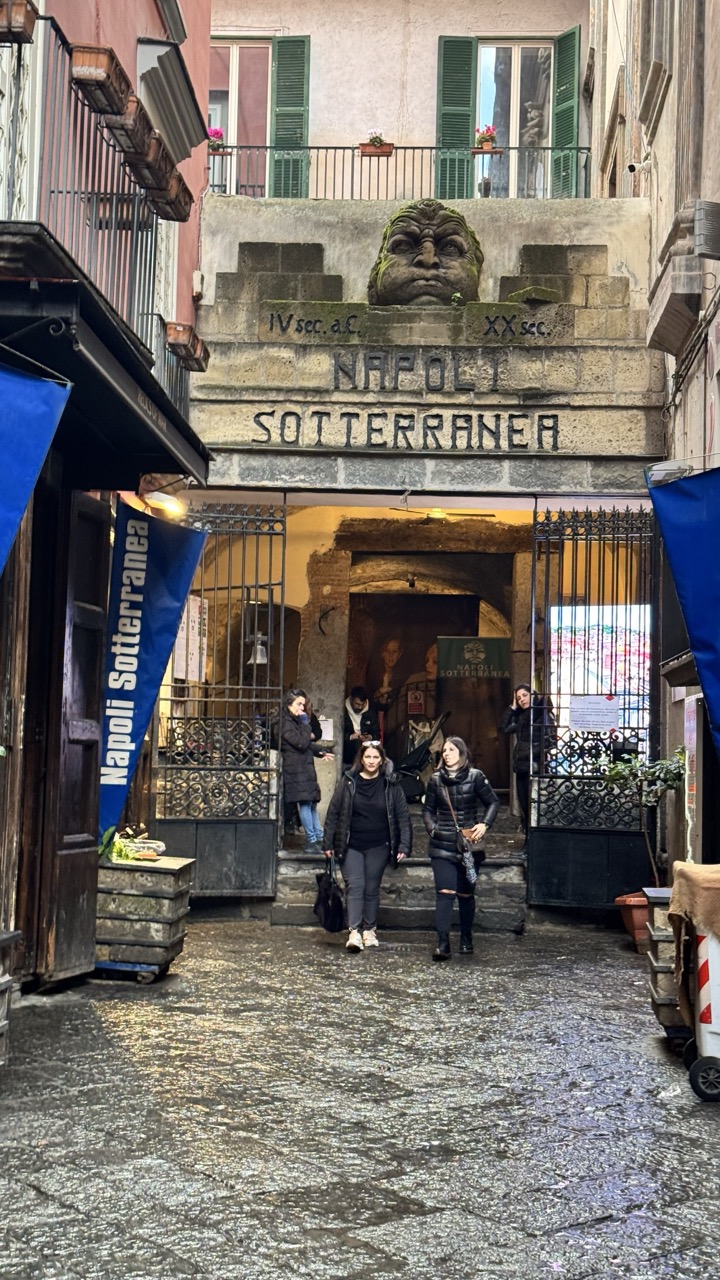

Underground Grumbles
Rating: 9/10
This image captures the intriguing entrance to Napoli Sotterranea, where history quite literally stares you down from above in the form of a wonderfully mossy, slightly grumpy-looking stone head. The scene is set on a wet cobblestone street, reflecting the overcast light and adding a slick, atmospheric sheen. People are milling around the gate, drawn into the depths of Naples' subterranean secrets, or perhaps just trying to escape the damp weather. The signage proudly declares "NAPOLI SOTTERRANEA," flanked by inscriptions hinting at ancient origins (IV sec. a.C.) and modern relevance (XX sec.), giving a sense of the vast historical scope contained within. Blue banners on the left add a pop of color against the muted stone and brick, beckoning visitors closer.
From a photography perspective, the composition does a solid job of framing the entrance within the narrow confines of the street, drawing the eye directly towards the historical gateway. The wet street is a fantastic element, adding texture and depth through its reflections, though one might lament the absence of dramatic light typical of sunnier Neapolitan days. The overcast lighting provides a flat, even exposure, which is great for detail but less exciting artistically. The subject matter is undeniably strong – an ancient city's underground is inherently fascinating – and the contrast between the ancient sculpture, the sturdy gates, and the modern visitors works well. Overall, it's a successful capture of a specific moment and place, hinting at the mysterious history that lies beneath the surface, even if the lighting is as flat as a disappointed tourist's expression on a rainy day.
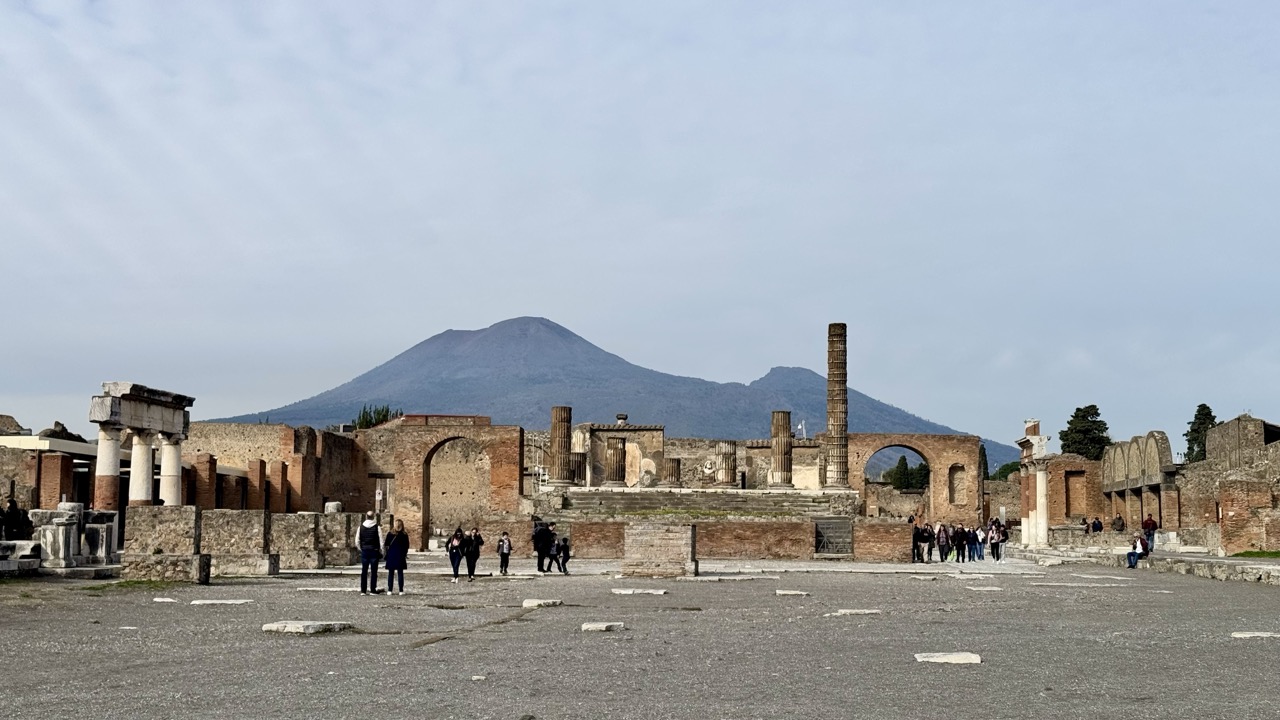

Pompeii: A Volcanic Backdrop
Subject Rating: 9/10
This image captures the iconic view of the ruins of Pompeii with Mount Vesuvius standing majestically (or perhaps menacingly, depending on your historical perspective) in the background. What's happening is the eternal dance between history and tourism: modern-day visitors wander through the remnants of an ancient city, blissfully unaware (or perhaps acutely aware) of the massive natural force that ended its vibrant life. The mood is a fascinating blend of historical weight and casual exploration; the air feels thick with the past, yet the scene is populated by people in contemporary clothing, adding a slightly surreal layer. The subject matter itself – a perfectly preserved ancient city and the volcano that preserved it by destroying it – is undeniably compelling, providing endless photographic opportunities.
From a photography standpoint, the composition is classic: a wide shot that grounds the viewer in the immediate foreground of the excavation site, uses the ruined structures in the midground to create depth and texture, and climaxes with the dominant peak of Vesuvius anchoring the background. The light is soft and diffused thanks to the overcast sky, which is great for preserving detail across the scene and preventing harsh shadows, though it does rob the image of dramatic contrasts and vibrant colors. The palette is appropriately muted, focusing on the earthy reds of the brickwork, the grey stones, and the hazy blues and greys of the sky and mountain – fitting for a scene steeped in antiquity and geological forces. It's a solid, documentary-style approach, effectively capturing the key elements of this world-famous location, even if the lighting doesn't offer much flair.
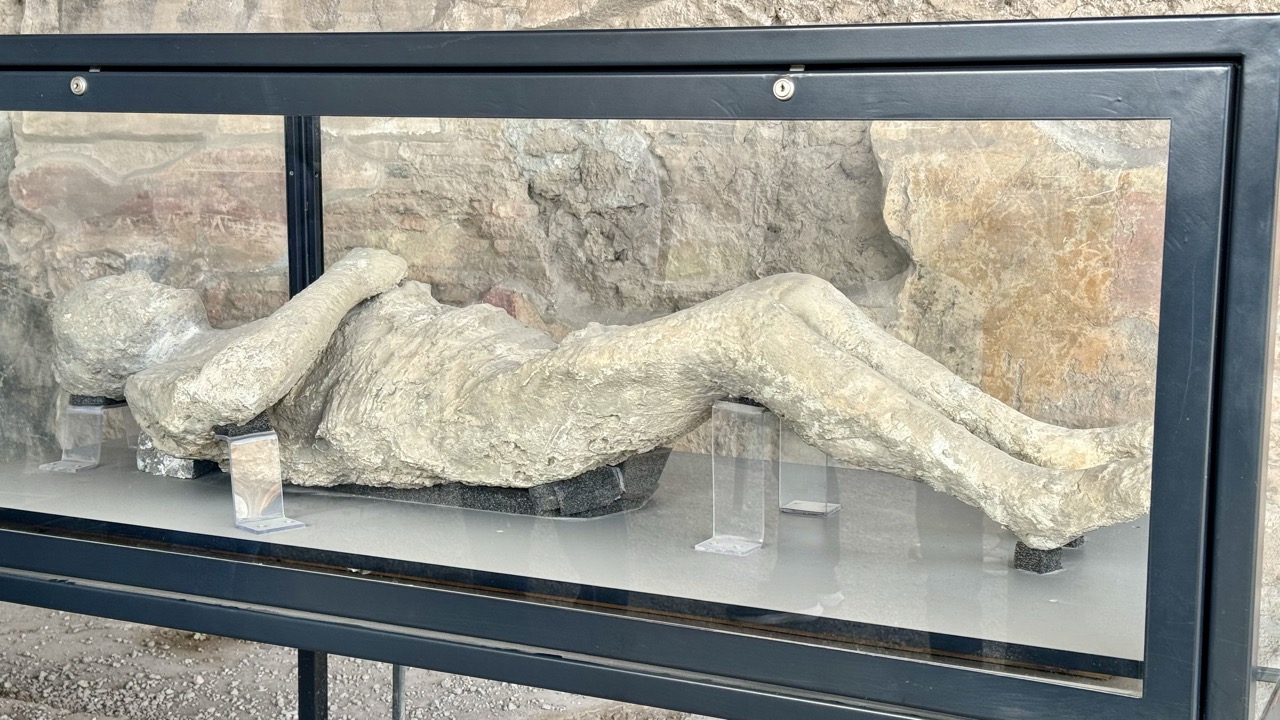

Pompeii's Eternal Nap
Subject Rating: 8/10
Here we have the ultimate "after" photo: a plaster cast of a person caught in their final moments during the eruption of Mount Vesuvius in 79 AD, now resting eternally in a glass case in Pompeii. This gentleman (or lady?) appears to have been quite relaxed right up until the, well, unpleasantness. Lying on their back with an arm tossed over their face, they strike a pose that says "I'm just having a little lie-down, please hold my calls." The rough, textured surface of the cast perfectly captures the contours of their body as preserved by the ash, displayed here on black supports and clear plastic risers within a dark-framed exhibition case. The mood is undeniably somber and reflective, making you ponder the fleeting nature of life and the terrifying power of nature – and perhaps also making you appreciate modern ventilation systems. Behind our ancient friend is the actual stone wall of a Pompeii building, adding a layer of authentic, slightly crumbling history to the scene.
From a photographic standpoint, capturing this piece of tragic history presents a few challenges. The composition centers the cast effectively within the frame of the display case, giving it prominence. However, the glass case itself is a photographer's nemesis, introducing noticeable reflections that distract from the subject – you can even see fragmented reflections of the background wall and potentially the photographer's surroundings. The lighting seems to be natural, perhaps ambient light filtering into the display area, which provides decent illumination but doesn't entirely cut through the glass issue. The color palette is appropriately muted, dominated by the earthy tones of the cast and the ancient stone background, reinforcing the historical and somewhat desolate atmosphere. Overall, it's a documentary-style shot that gets the job done, albeit battling the inherent difficulties of shooting through reflective surfaces. Maybe next time, pack a polarizing filter and a note asking the volcano to hold off until after the shoot.
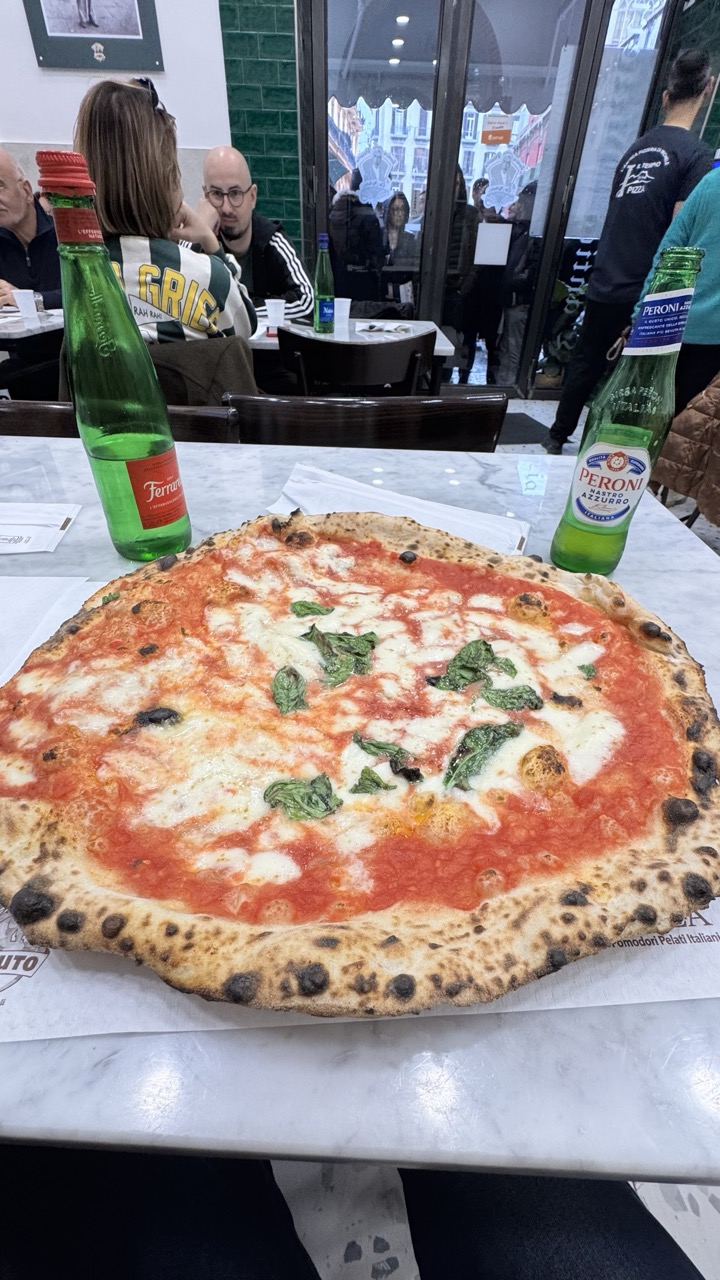

Pizza, Peroni, and Pizza Pilgrims: A Foreground Feast
Rating: 7/10
This image is a glorious, unapologetic ode to delicious Italian food, placing a truly massive Margherita pizza front and center, almost spilling out of the frame. Flanking this cheesy, saucy masterpiece are two bottles, a refreshing Ferrara water and a classic Peroni beer, standing like sentinels guarding the feast. In the background, the warm, inviting ambiance of a bustling restaurant unfolds, complete with people dining, green subway tiles adding a splash of character, and a peek through the windows into a lively street scene beyond. The mood is undeniably casual and celebratory, capturing that perfect moment of anticipation before diving into a fantastic meal.
From a photography perspective, this shot employs a low-angle, close-up perspective that dramatically emphasizes the scale and texture of the pizza. While it creates a sense of intimacy with the food, it also results in a slightly awkward composition, chopping off parts of the pizza's edges and making the bottles feel a bit like accidental additions rather than deliberately placed props. The shallow depth of field effectively isolates the pizza, ensuring your eyes go nowhere else, but it renders the background a bit too blurry to fully appreciate the environment. The lighting is functional, highlighting the pizza's vibrant colors, though lacking dramatic flair. It’s less a composed masterpiece and more a enthusiastic "Look what I'm about to eat!" snapshot, but it perfectly conveys the subject's irresistible appeal.
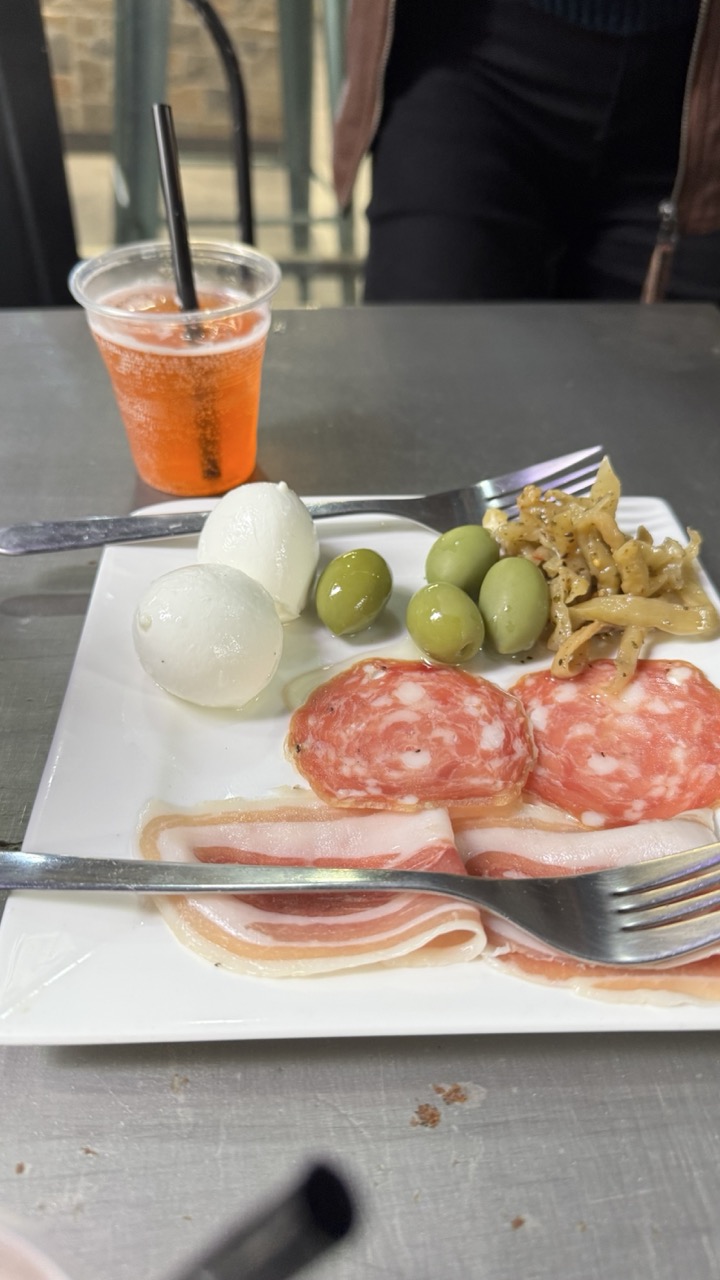

Antipasto Assault Prep
Rating: 6/10
This photo captures a delightful spread of antipasto, featuring plump mozzarella balls, vibrant green olives, slices of rich salami, and delicate folds of what appears to be prosciutto or pancetta, ready for consumption on a simple white plate. Accompanied by a bright orange drink in a plastic cup with a straw and an assortment of pickled vegetables, the scene is set for a casual, perhaps slightly eager, snack or meal. The mood is relaxed and focused squarely on the impending deliciousness, with forks strategically placed, hinting at an imminent culinary engagement. It's a snapshot of simple pleasures about to be devoured, capturing the anticipation of digging in.
From a photographic standpoint, this shot is a candid moment rather than a styled presentation. The composition centers the plate but leaves a fair amount of plain table space at the bottom, and the forks awkwardly bisect the food, looking more like tools of destruction than framing elements. Lighting is ambient and a bit flat, causing reflections on the shiny table surface and not particularly highlighting the textures of the food, although the colors of the olives and drink provide some welcome contrast against the grey table. The background is nicely blurred, isolating the subject, but the partial view of a person adds a slightly distracting element. Overall, it's a functional record of the meal, but lacks the dynamic lighting or careful composition that would elevate it beyond a typical "dinner pic."
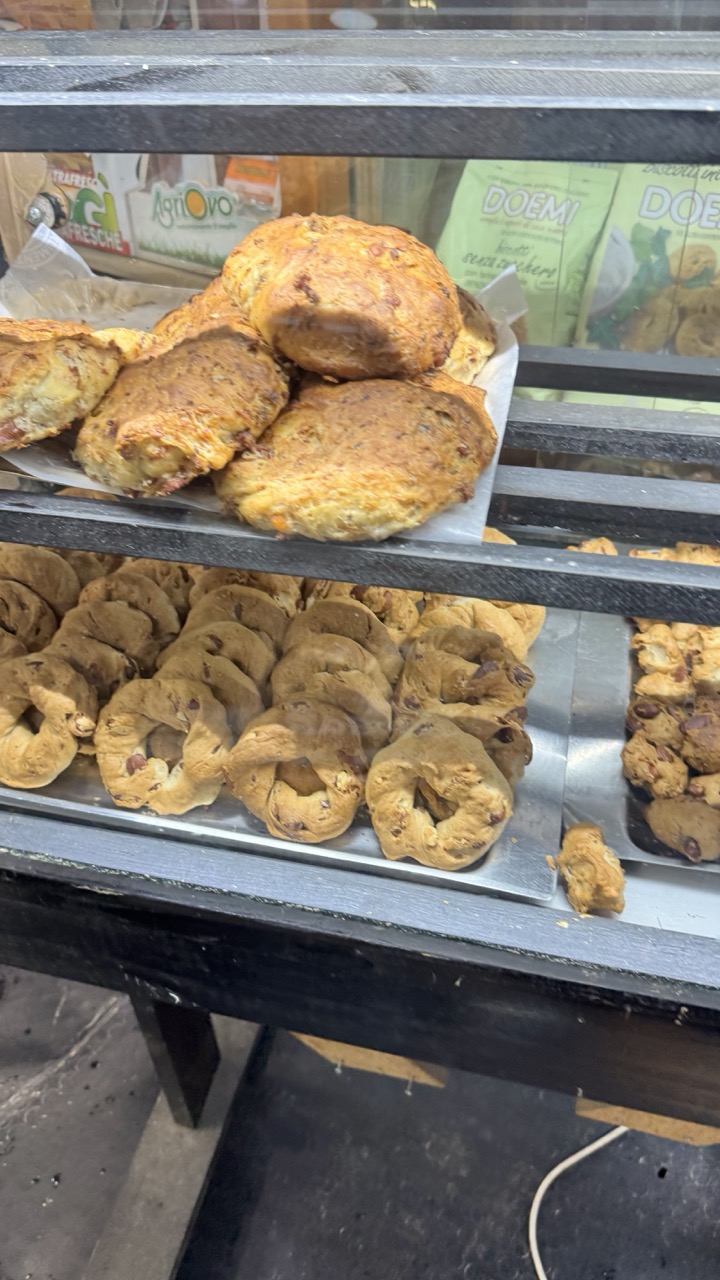

Bakery Bonanza - Shelf Life Edition
Rating: 7/10
This image plunges us headfirst into a display case overflowing with baked goodness, a true feast for the eyes if not for the waistline. On the top shelf, a pile of substantial, savory-looking pastries promises a hearty bite, their rustic surface hinting at delicious, perhaps cheesy or meaty, fillings. Below them, neat rows of ring-shaped biscuits, likely a variety of taralli, beckon with their satisfying crunch potential, embedded with visible bits that look like olives or sundried tomatoes. The bottom right corner offers a glimpse of smaller, chunkier cookies or biscuits, completing this carb-laden trio. The mood is unpretentious and abundant, capturing the simple pleasure of a well-stocked local bakery or market stall. It’s less about fancy presentation and more about getting down to the delicious business of baked goods.
From a photographic standpoint, this shot is a straightforward documentation of the display, albeit with a few quirks. The vertical composition effectively stacks the different offerings, giving us a clear overview of the variety available. However, the lighting is rather dramatic, with a bright hot spot on the top pastries that unfortunately obscures some detail, making them look like they're about to ascend. The lower shelves fare better in terms of exposure, allowing the textures of the ring biscuits and cookies to show through. The focus is a bit soft in places, giving a slightly dreamy quality to the scene, perhaps mirroring the sugar rush one might get from indulging. The background, blurred packaging with hints of green and brand names like "AgriOvo" and "DOEMI senza zuccheri," confirms the retail setting, adding a touch of contextual realism to this celebration of baked delights.
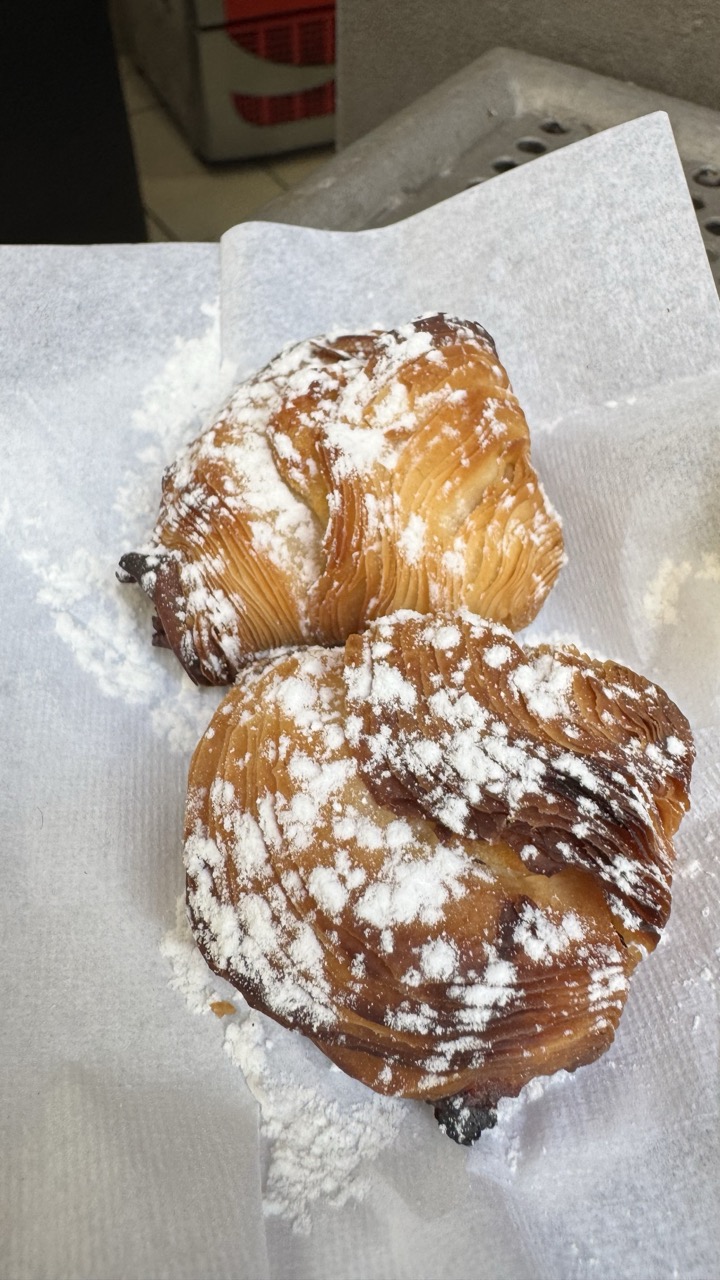

Flaky Wonders Powdered Perfection
Rating: 9/10 (Almost perfect, but they aren't *in my mouth* yet)
Ah, the noble pastry in its natural habitat: perched on a sheet of paper, daring you to ignore its flaky, sugary charm. We've got two magnificent specimens here, absolutely drowning in powdered sugar, which, let's be honest, is the *real* reason we eat these things. The subject matter is undeniably appealing, a classic indulgence that screams "eat me!". The mood? Pure, unadulterated temptation, served with a generous side of "don't worry about the mess, it's delicious." It perfectly captures that moment of anticipation before diving into something truly decadent, embodying a warm, inviting tone.
From a photographic standpoint, the composition is straightforward but effective, a close-up that puts the pastries front and center. The slightly angled perspective adds a touch of visual interest without being distracting. The lighting does a fantastic job of highlighting those incredible layers and the texture of the sugar – looks like natural or soft ambient light from the left, creating just enough shadow to give them form and dimension. The color palette is warm and inviting, focusing on the golden browns of the baked goods contrasted with the bright white of the sugar and paper. The background is intentionally blurry, a bokeh effect that pushes the pastries forward, though the vague shapes and colors hint at a less-than-glamorous environment, perhaps a bustling bakery counter rather than a styled studio. The style is casual food photography, focusing on texture and immediate visual appeal, which is certainly achieved here with objects limited to the pastries and the paper.
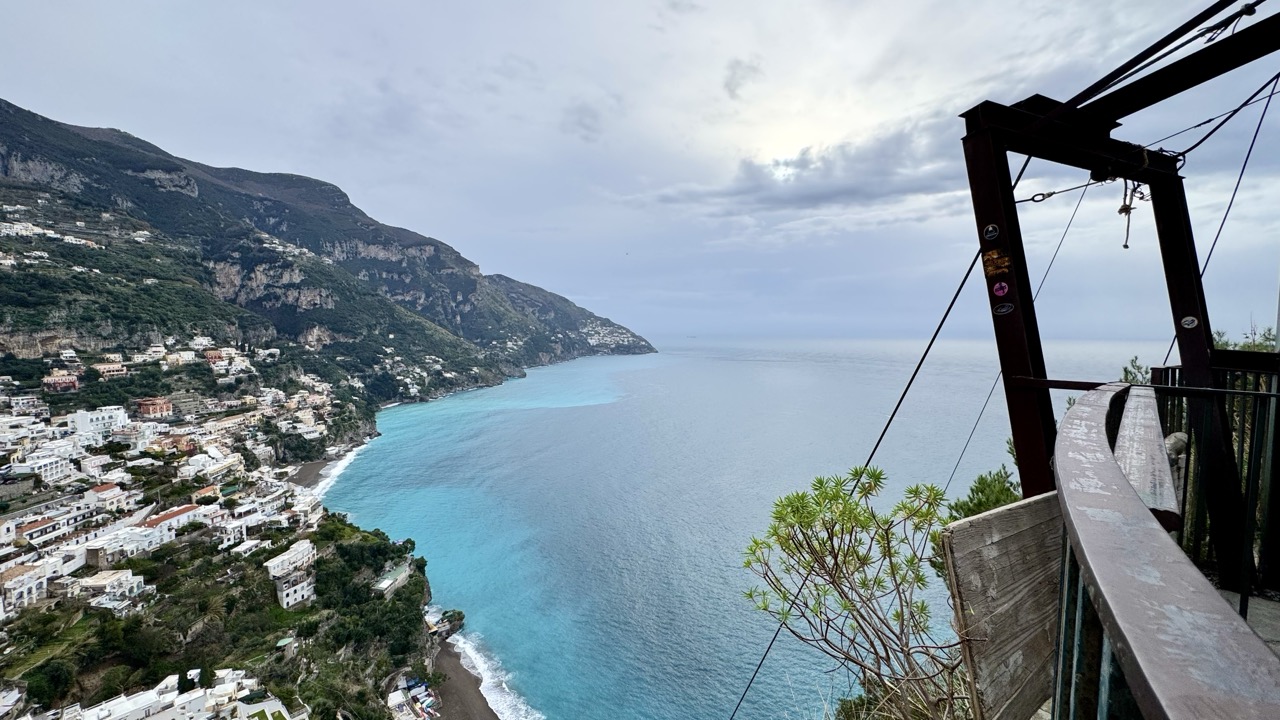

A View (Almost) Unobstructed
Subject Rating: 8/10
This image captures the dramatic beauty of a coastal town, likely Positano, cascading down steep hillsides towards a stunning bay. The subject, the iconic clustered white buildings against the lush green cliffs and the vibrant blue sea, is truly breathtaking, earning a high rating for its inherent photogenic qualities. The sea itself is a spectacle, displaying a distinct shift from a bright, almost turquoise near the shore to a deeper sapphire further out, suggesting different depths or perhaps water currents. The scene is one of serene beauty and impressive topography, conveying a mood that is both awe-inspiring and slightly dramatic under the soft, overcast sky.
From a photography perspective, the composition uses a strong foreground element – a rustic metal structure with a railing – to frame the expansive view, placing the viewer at a specific vantage point. While the structure adds context to the viewing experience, its prominence on the right edge, combined with a slight horizon tilt, can feel a little distracting from the natural grandeur of the town and coastline. The lighting is soft and diffused due to the cloudy sky, which is excellent for bringing out the rich colors of the sea and foliage without harsh shadows, though it lacks the dynamic contrast of sunnier conditions. Details like the scattered stickers on the metalwork add a touch of unintentional realism and maybe a bit of human grit to the otherwise postcard-perfect landscape. It's a solid capture of a world-renowned view, perhaps suggesting that sometimes, even with slightly imperfect framing, the subject's beauty shines through.
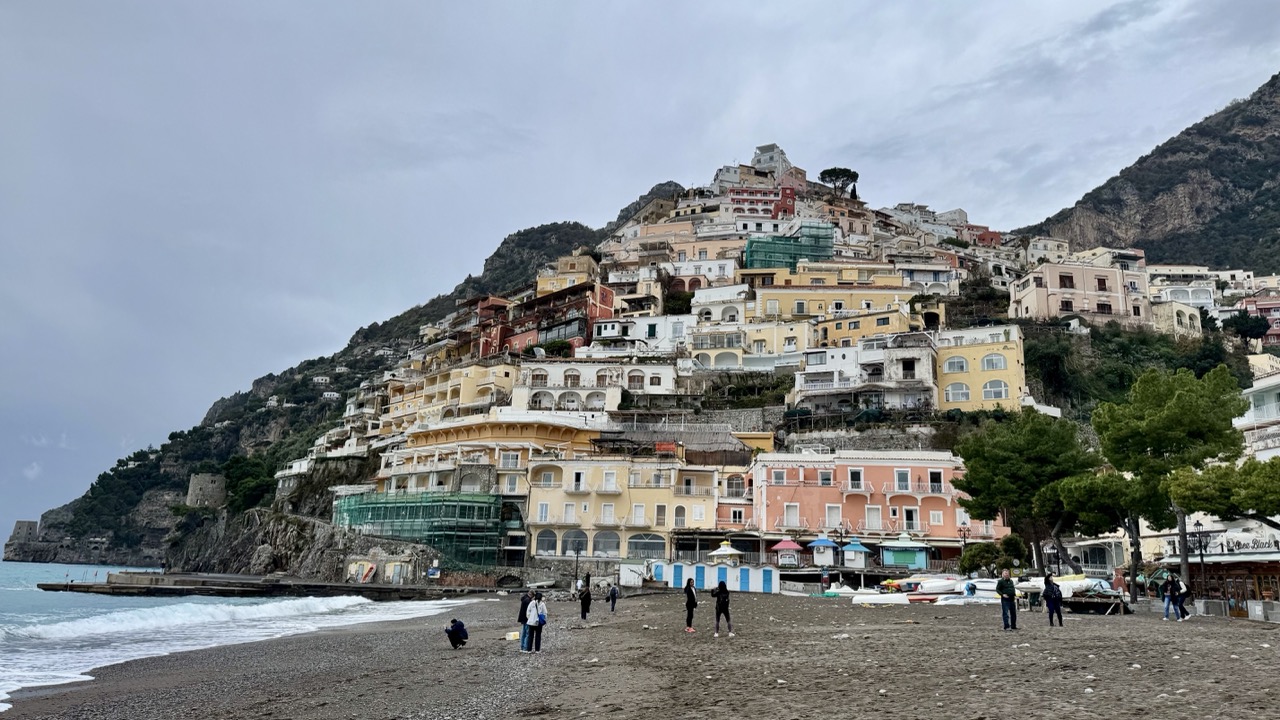

Positano's Moody Embrace
Subject Rating: 9/10
Here we see the iconic, gravity-defying beauty of Positano on the Amalfi Coast, clinging precariously to the steep hillside like barnacles on a very fancy rock. The subject is an absolute showstopper, earning a high score despite Mother Nature's decision to provide a rather moody, overcast sky for the occasion. On the grey pebble beach below, a scattering of people are enjoying a low-key day, perhaps contemplating the sheer number of steps required to reach the upper levels of the village or simply enjoying the gentle waves lapping at the shore. The mood is one of quiet dramatic beauty; even stripped of harsh sunlight, the pastel-colored buildings retain their charm against the rugged, dark green slopes of the mountain, offering a more tranquil view than the usual bustling sunny postcards.
From a photography perspective, the composition effectively captures the overwhelming verticality of Positano, using the beach and the line of the coastline to anchor the scene before the eye sweeps up the cascading layers of buildings. The overcast sky provides lovely diffused light, which is fantastic for rendering detail without harsh shadows, although it does mute the vibrant colors the town is famous for – perhaps a touch of post-processing saturation is in order for that classic Positano pop! The soft light highlights the textures of the buildings and the rocky cliff face. The foreground figures provide a sense of human scale against the monumental landscape, though one can't help but notice the rather unfortunate green scaffolding on one prominent building, a stark reminder that even paradise needs a little fixing up now and then. It’s a solid travel shot capturing the essential character of the location, even on a less-than-sunny day.
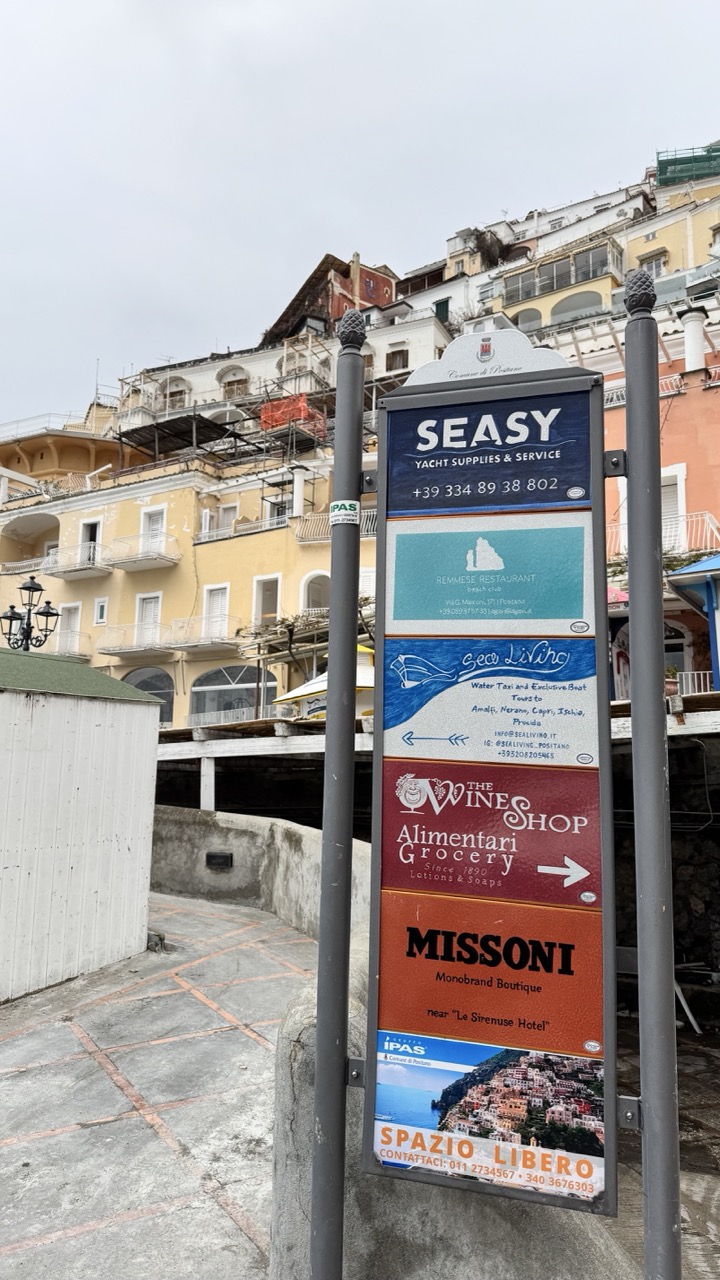

Positano's Necessary Distraction
Rating: 6/10
This photo captures a multi-panel signpost in Positano, Italy, the practical element of navigation awkwardly placed against the town's iconic, postcard-perfect (though slightly scaffolded) cliffside architecture. The sign serves its purpose admirably, listing essential services like yacht supplies (SEASY), restaurants (Remmese), water taxis (Sea Living), and even a Missoni boutique and grocery store, trying desperately to grab attention from anyone whose gaze isn't fixed on the stunning, vertically-stacked buildings rising behind it. The mood is one of charming function juxtaposed with overwhelming natural and architectural beauty, albeit under a rather muted, overcast sky that lends a soft, diffused light to the scene, toning down the vibrant colours Positano is famous for.
From a photographic perspective, the composition places the sign prominently on the right, acting as a strong vertical anchor, yet it can't help but feel like a foreground element competing with the true subject – the sprawling townscape. The soft, grey lighting means there are no harsh shadows, but it also flattens the scene somewhat, reducing the drama. However, the bright, colourful panels of the sign pop effectively against the more subdued hues of the buildings and sky. The pathway and low wall in the foreground add depth, leading the eye towards the informational display, while the lamppost on the left provides a partial frame, almost like an unintentional bookend to the signpost's message board chaos. It's a candid snapshot capturing a functional moment in a highly picturesque location, proving that even paradise needs directions.
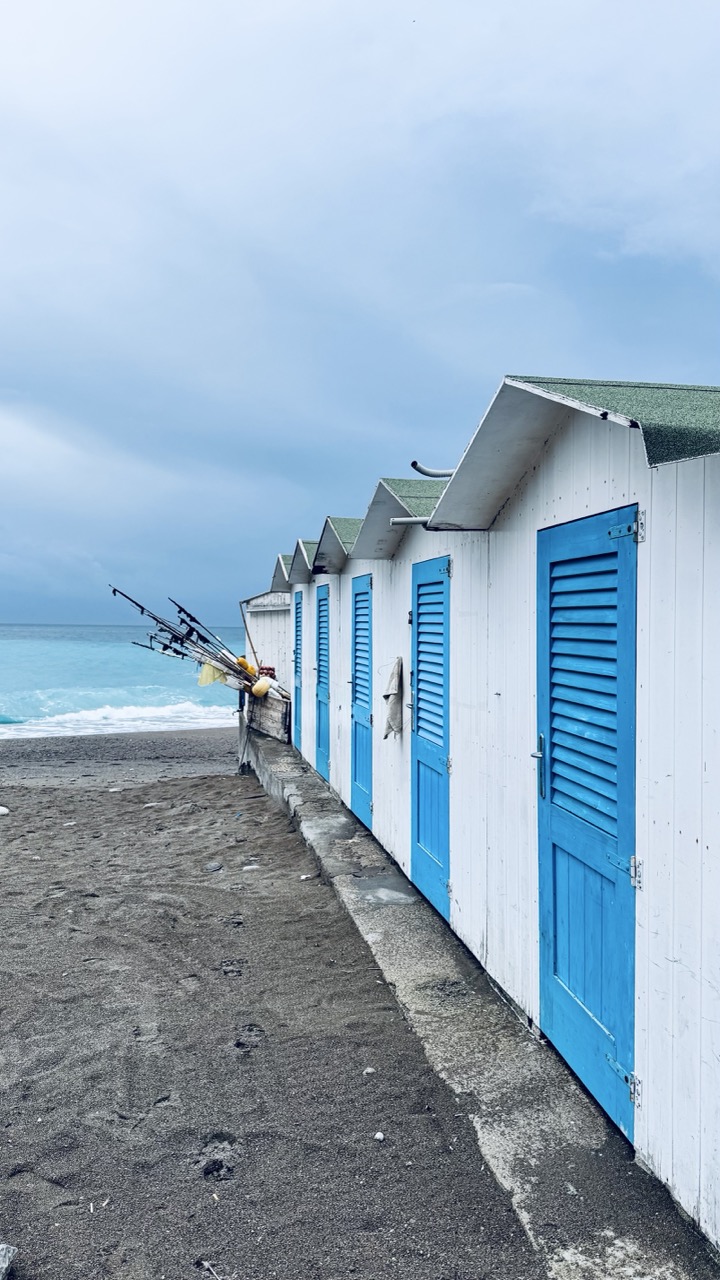

The Blues Brothers... of Beach Huts
Rating: 7/10
Here we have a classic seaside scene featuring a lineup of identical white beach huts, each proudly displaying its brilliant blue door as if attending a very exclusive, very uniform convention. The grey, pebbly sand and the moody, overcast sky provide a suitably atmospheric backdrop for this architectural parade. To the left, the turquoise sea churns under the cloudy heavens, adding a touch of dramatic color to the otherwise muted palette. A bundle of fishing rods leaning against the first hut suggests that despite the somewhat somber weather, someone has been trying their luck or is planning to soon – clearly, dedication levels here are higher than the cloud base. There are even a few intrepid footprints marking the sand, evidence that someone braved the likely drizzle to admire this regimented coastal storage. It’s a familiar subject, captured with straightforward honesty, hence the respectable 7/10 subject rating.
From a photographic standpoint, the composition effectively uses the diagonal line of the huts and the concrete path as leading lines, guiding the viewer's eye towards the sea and the horizon. The vertical format is well-suited to capturing the height of the huts and the expansive sky. The lighting is the classic softbox effect of an overcast day – perfect for avoiding harsh shadows but perhaps lacking the punch that dappled sunlight might provide. However, this soft light truly allows the vibrant blue doors to stand out, creating a pleasing color contrast against the neutral tones. The repetition of the huts creates a strong visual rhythm across the frame, while the small details like the fishing gear and the towel on the door add narrative touches to what could otherwise be a purely architectural study. It’s a competent and atmospheric shot that captures the quiet solitude of a cloudy day at the beach.
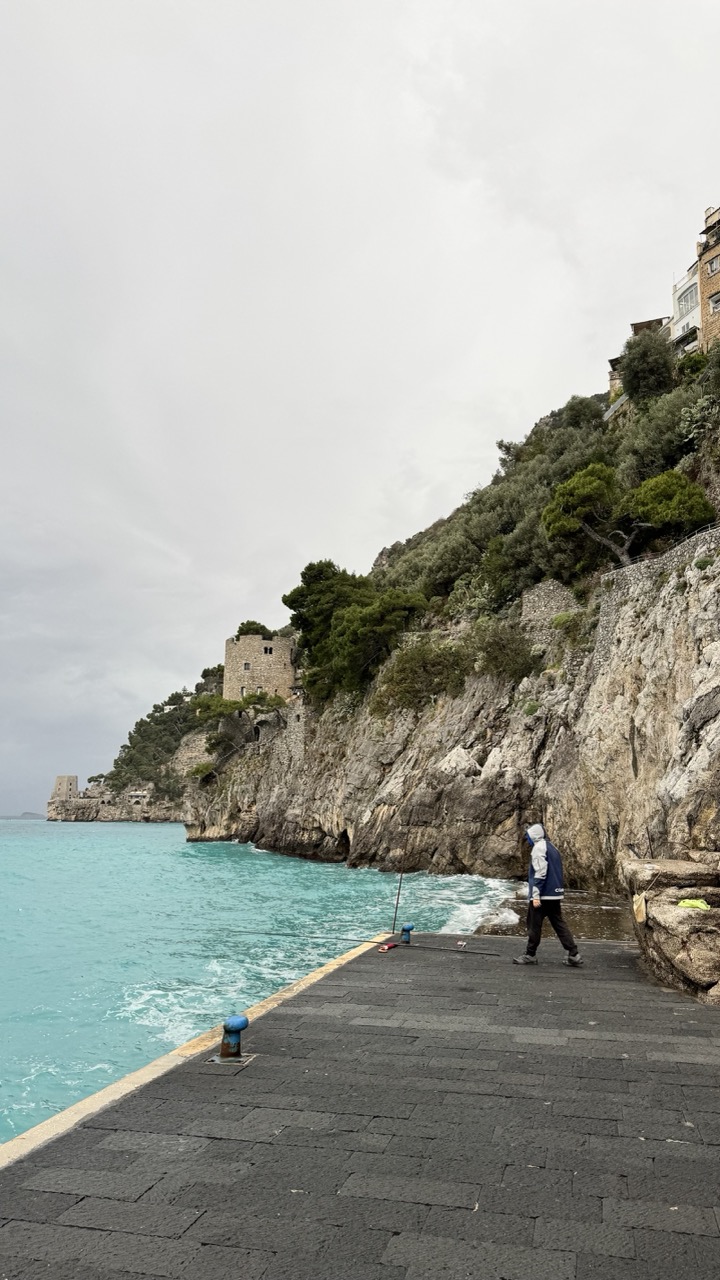

Amalfi Coast Moody Walk
Rating: 8/10
Ah, the classic "overcast day makes for dramatic lighting" trope, perfectly executed here with a stunning slice of the Amalfi Coast. The subject matter is undeniably gorgeous, even if the sun decided to take a rain check (literally, perhaps?). We've got towering, rugged cliffs, looking like nature just decided to pile some rocks really high, draped in lush, slightly windswept greenery. Nestled precariously among the rocks are these incredible old stone buildings and towers, clinging on for dear life, suggesting centuries of stubborn resilience or perhaps just a lack of building permits elsewhere. Down below, the star of the show, despite the grey sky, is that impossibly vibrant turquoise water. It's so blue it almost looks artificial, like someone spilled a giant bottle of Windex into the Mediterranean. Our lone figure on the pier, bundled up and seemingly contemplating the waves or the secrets hidden beneath the pier stones, adds a touch of human scale and narrative to this grand vista.
From a photographic standpoint, the composition works nicely, using the diagonal lines of the dark pier to lead the eye towards the cliff face and the vibrant water. The vertical format emphasizes the sheer scale of the cliffs, making the buildings look even more like dollhouses perched on a giants' rockery. The lighting, while diffuse due to the overcast sky, provides soft, even illumination, which is great for landscapes as it reduces harsh shadows and maintains detail throughout the scene. However, it does mean the sky is a bit of a bland grey canvas – perhaps a perfect opportunity for some cloud replacement or a dramatic black and white conversion, just saying. The limited color palette relies heavily on the contrast between the intense turquoise water and the more muted greys and greens, which is quite effective. The scattered fishing gear near our lone ranger suggests a quiet morning of angling that may or may not have yielded any results. A solid shot capturing the moody beauty of this iconic coastline, even without the benefit of golden hour.
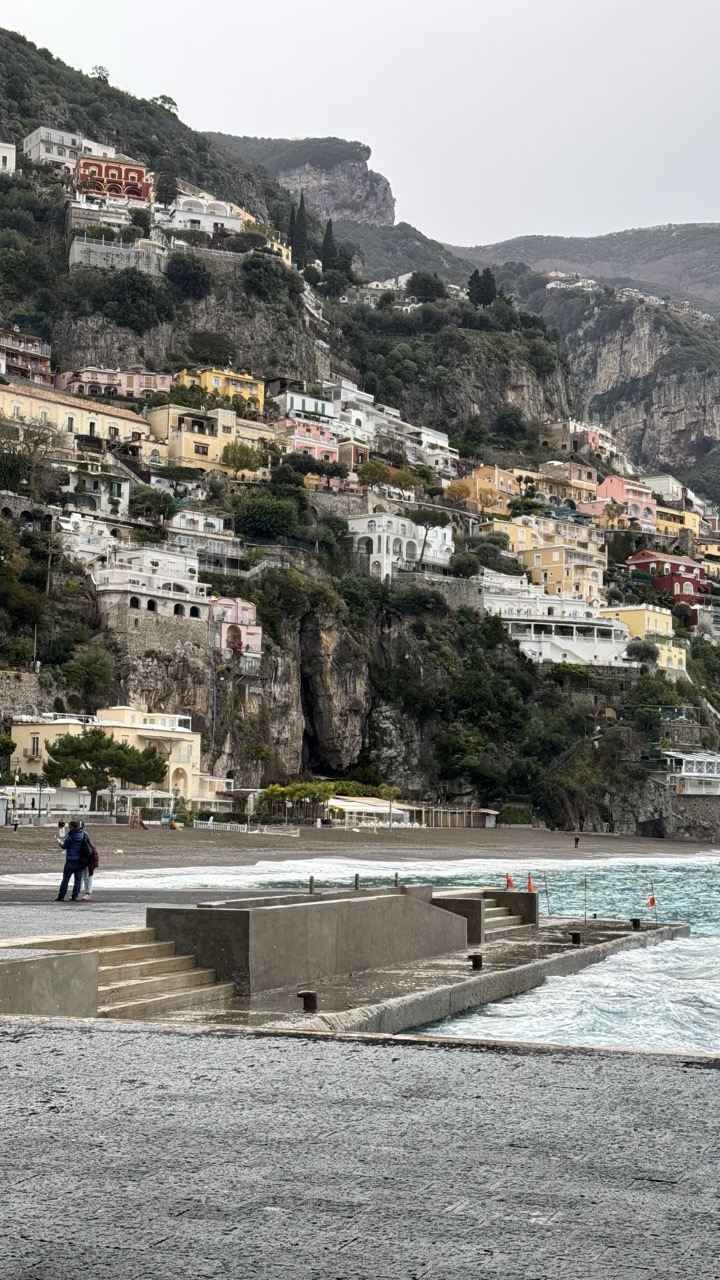

Positano Under Grey Skies
Rating: Subject Matter: 9/10
This image captures the iconic, vertically stacked town of Positano clinging precariously to the steep cliffside overlooking the Tyrrhenian Sea. The subject matter itself is breathtakingly beautiful and instantly recognizable, earning it a high rating. Despite the somewhat dreary, overcast sky, the pastel-colored buildings, ranging from vibrant yellows and pinks to classic whites, still pop against the deep green of the surrounding vegetation and the grey rock faces. The scene depicts a typically dramatic view of this famous coastal town, with the densely packed houses seemingly tumbling down towards the dark sand beach below. A few figures are visible on the beach and the foreground structure, adding a sense of scale and human presence to the grand landscape.
From a photographic perspective, the composition is dominated by the strong vertical elements of the cliff and buildings, contrasted with the horizontal lines of the beach, sea, and foreground pier. The concrete structure in the foreground, while perhaps not the most aesthetically pleasing element, serves to ground the image and provides a distinct viewpoint, separating the viewer from the classic postcard vista. The lighting, provided by the overcast sky, offers soft, diffuse light, which avoids harsh shadows but also mutes the vibrancy of the colors slightly, contributing to a mood that feels more dramatic or contemplative than a sunny day would. The style appears to be a travel snapshot, capturing the scene as encountered, with a focus on documenting the stunning location rather than a highly stylized artistic shot. The choppy water adds texture and movement to the lower part of the frame, contrasting with the static solidity of the town.
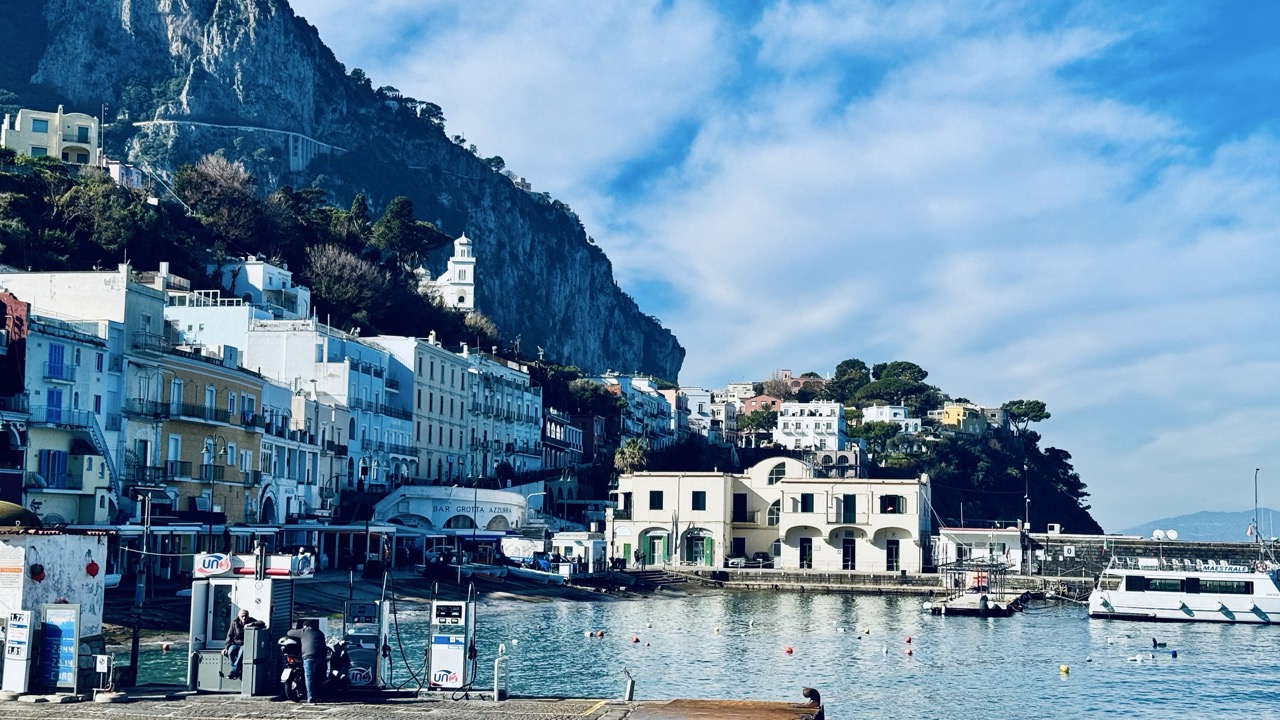

Fueling the Italian Dream
Subject Rating: 9/10
This vibrant image captures a slice of life in a picturesque Italian harbor town nestled against a dramatic, towering cliff face. The scene is a delightful blend of the stunning natural landscape and human activity, showcasing colorful buildings clinging to the hillside and a busy waterfront. We see people engaged in various activities, including what appears to be refueling scooters or perhaps small boats at a surprisingly prominent gas station right on the dock. A sleek white boat, possibly a ferry or tour boat labeled "MAESTRALE", is moored in the sparkling blue water alongside smaller vessels. The mood is lively and sunny, evoking the quintessential feel of a bright day in a beautiful, bustling coastal location.
From a photography perspective, the composition offers a tiered view, moving from the utilitarian foreground of the dock and gas station to the charming, stacked buildings and culminating in the imposing rocky cliff under a bright blue sky dotted with dynamic clouds. The lighting is strong and clear, casting sharp shadows and highlighting the textures of the cliff and the vibrant colors of the buildings. While the composition isn't strictly classical, the inclusion of the gas station adds an unexpected and somewhat humorous element to the otherwise postcard-perfect Italian backdrop, grounding the scenic beauty in the reality of daily life – even stunning locations need fuel! The colors are punchy, adding to the lively and inviting atmosphere of this unique harbor.
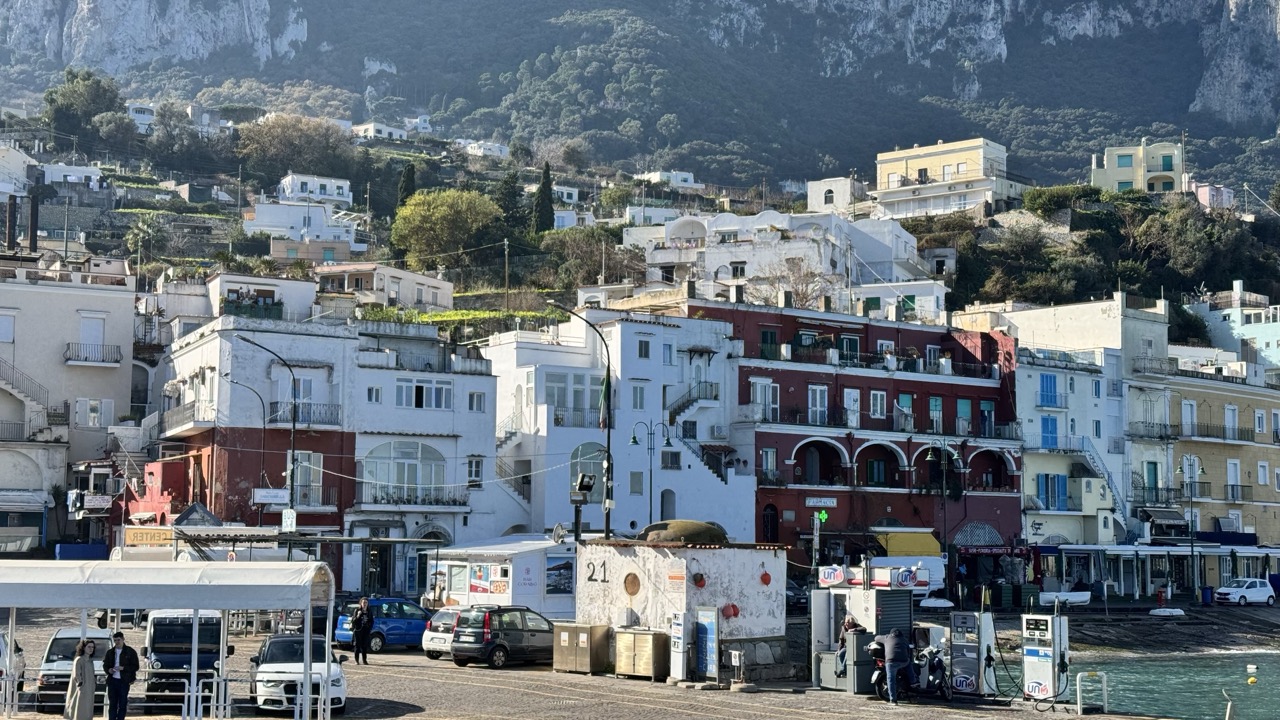

Title: Harbor Town Layers
Subject Rating: 8/10
Welcome to a vibrant Mediterranean port town, where colorful buildings cling precariously to a steep hillside, creating a visual feast of stacked architecture. The subject, a picturesque coastal settlement nestled against dramatic cliffs, scores a solid 8/10 for sheer scenic charm. What's happening is the everyday hustle and bustle of harbor life: cars parked and driving, people strolling, a scooter waiting at a gas station, all under the bright Mediterranean sun. The mood is lively and sunny, capturing the essence of a busy tourist destination or a working port on a fine day. It's a snapshot that feels immediate and full of life.
From a photographic standpoint, the composition is a delightful study in layers, moving from the busy foreground of the street and harbor edge through the densely packed buildings in the midground, culminating in the imposing, tree-covered cliff face in the background. The lighting, likely late afternoon, casts strong shadows that define the architectural details, though it might be a tad harsh for portraiture – but who needs portraits when you have this landscape? The color palette is classic Mediterranean: pops of red, yellow, and blue against dominant whites, all grounded by the natural greens and greys. Pertinent objects like the prominent "21" building sign and the Uni gas station pumps root the scene firmly in reality, providing scale and context amidst the beauty. It's a composition that could benefit from a slightly cleaner foreground, perhaps less asphalt and more sparkling water, but the sheer visual density of the town climbing the hill is undeniably captivating, making it a compelling scene for any photographer.
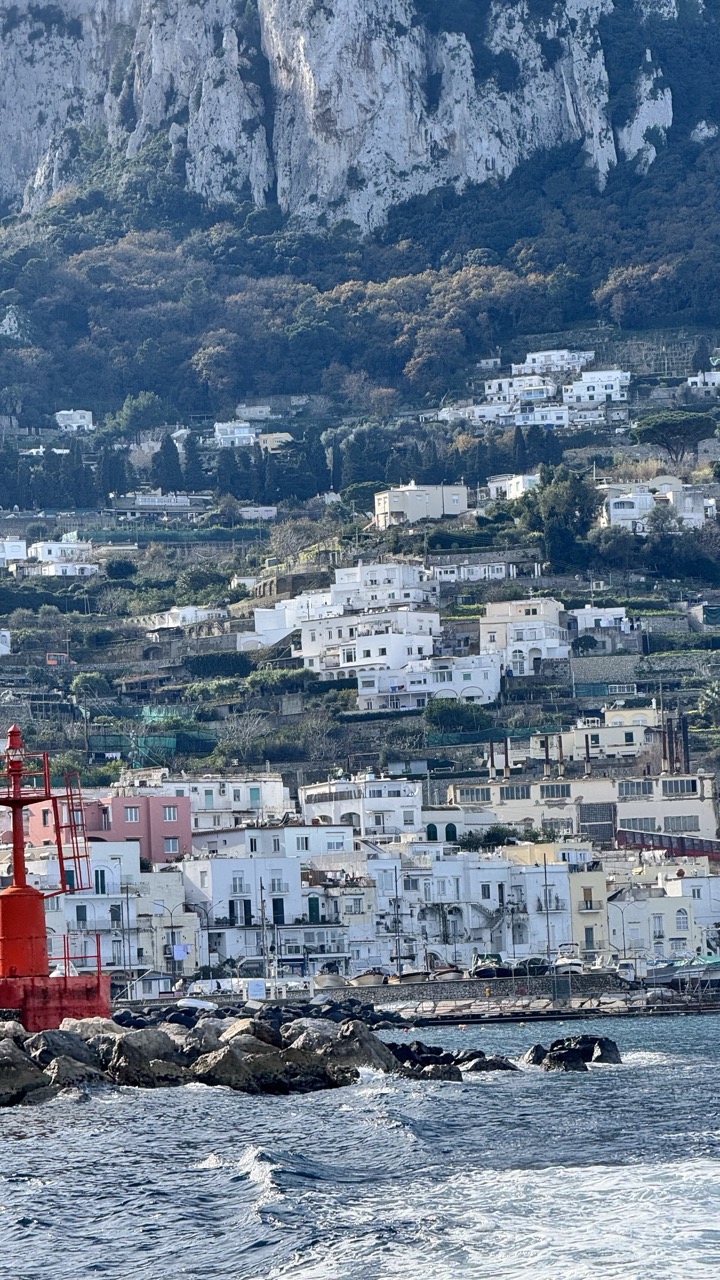

Capri Coastal Ascent
Rating: 9/10 - A visually stunning subject, offering a complex and layered view of human habitation clinging precariously to dramatic natural landscapes.
This vertical vista plunges the viewer into the quintessential scene of a Mediterranean island town, likely the iconic Capri, with white buildings cascading down a steep hillside towards the azure sea. It's less about a singular event and more about the enduring presence of a community nestled against formidable cliffs, a static tableau punctuated only by the gentle movement of the waves in the foreground. The mood is one of breathtaking beauty and perhaps a touch of awe at the sheer audacity of building here – one can almost feel the calf burn just looking at all those terraces. The scene is classic postcard material, offering a glimpse into a lifestyle intertwined with the dramatic coastal geography.
From a photographic perspective, the vertical composition is a smart choice to emphasize the height and steepness of the climb from the harbor to the upper reaches of the town and cliffs. The lighting, casting shadows and highlights across the terraced landscape, reveals the texture of the buildings and the ruggedness of the terrain, though the overall light feels a little flat, perhaps due to high sun or slight haze. The color palette is dominated by the vibrant whites of the buildings contrasting with the deep blues of the water and the varied greens and browns of the vegetation-clad slopes, all anchored by the bold, almost assertive red of the lighthouse in the lower left, which serves as a strong, grounding focal point against the busy background. It's a chaotic beauty, with architecture seemingly sprouting organically from the rocky slopes, presenting a delightful challenge for any photographer trying to capture its full, layered story without getting lost in the details or wondering if the foundation is *really* solid.
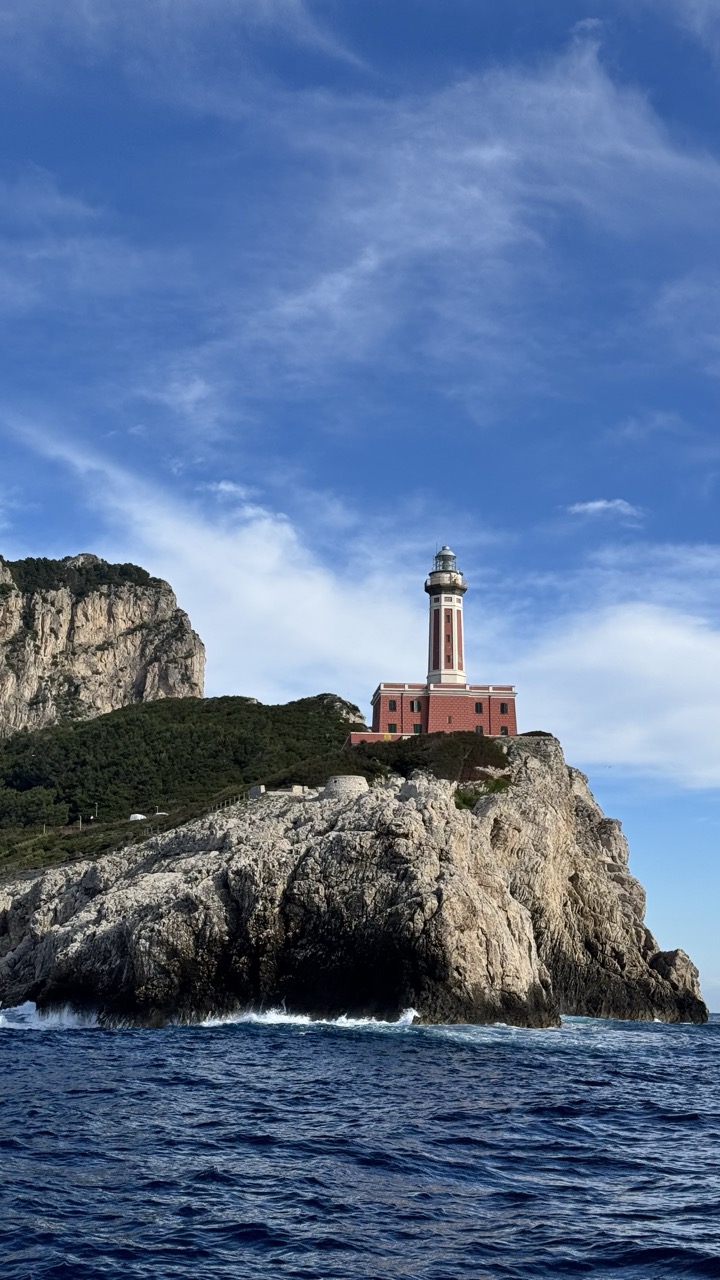

Faraglioni Watchman
Rating: 9/10
Here we see a majestic lighthouse standing sentinel on a rugged, rocky outcrop, a classic scene that screams 'Mediterranean postcard'. The deep blue sea churns below, crashing against the base of the cliff with foamy white waves, while the rich, warm terracotta of the lighthouse provides a striking contrast against the varied textures of the grey rock and dark green vegetation. Dominating the left side of the frame is a sheer, imposing cliff face, adding a sense of scale and drama to the composition. The mood is one of serene grandeur, a timeless tableau of nature's power and human perseverance, embodied by the steadfast structure guarding the coast.
From a photographer's perspective, the composition is strong, centering the iconic lighthouse while allowing the surrounding landscape – the sea, the cliffs, the sky – to provide context and depth. The lighting appears to be bright daylight, perhaps late morning or early afternoon, which brings out the vibrant blues of the water and sky and the distinct colors of the lighthouse, though it creates some strong shadows on the cliff face. The subject matter is inherently captivating, a blend of dramatic natural forms and a charming, historical structure. Shooting from the water offers a unique perspective, capturing the full height of the cliff and the relationship between the sea and the land, though mastering a stable shot on choppy water requires some nautical finesse – thankfully, it looks like the photographer nailed it without too much seasickness blurring the lines.


Pompeii: A Volcanic Backdrop
Subject Rating: 9/10
This image captures the iconic view of the ruins of Pompeii with Mount Vesuvius standing majestically (or perhaps menacingly, depending on your historical perspective) in the background. What's happening is the eternal dance between history and tourism: modern-day visitors wander through the remnants of an ancient city, blissfully unaware (or perhaps acutely aware) of the massive natural force that ended its vibrant life. The mood is a fascinating blend of historical weight and casual exploration; the air feels thick with the past, yet the scene is populated by people in contemporary clothing, adding a slightly surreal layer. The subject matter itself – a perfectly preserved ancient city and the volcano that preserved it by destroying it – is undeniably compelling, providing endless photographic opportunities.
From a photography standpoint, the composition is classic: a wide shot that grounds the viewer in the immediate foreground of the excavation site, uses the ruined structures in the midground to create depth and texture, and climaxes with the dominant peak of Vesuvius anchoring the background. The light is soft and diffused thanks to the overcast sky, which is great for preserving detail across the scene and preventing harsh shadows, though it does rob the image of dramatic contrasts and vibrant colors. The palette is appropriately muted, focusing on the earthy reds of the brickwork, the grey stones, and the hazy blues and greys of the sky and mountain – fitting for a scene steeped in antiquity and geological forces. It's a solid, documentary-style approach, effectively capturing the key elements of this world-famous location, even if the lighting doesn't offer much flair.


Pompeii's Eternal Nap
Subject Rating: 8/10
Here we have the ultimate "after" photo: a plaster cast of a person caught in their final moments during the eruption of Mount Vesuvius in 79 AD, now resting eternally in a glass case in Pompeii. This gentleman (or lady?) appears to have been quite relaxed right up until the, well, unpleasantness. Lying on their back with an arm tossed over their face, they strike a pose that says "I'm just having a little lie-down, please hold my calls." The rough, textured surface of the cast perfectly captures the contours of their body as preserved by the ash, displayed here on black supports and clear plastic risers within a dark-framed exhibition case. The mood is undeniably somber and reflective, making you ponder the fleeting nature of life and the terrifying power of nature – and perhaps also making you appreciate modern ventilation systems. Behind our ancient friend is the actual stone wall of a Pompeii building, adding a layer of authentic, slightly crumbling history to the scene.
From a photographic standpoint, capturing this piece of tragic history presents a few challenges. The composition centers the cast effectively within the frame of the display case, giving it prominence. However, the glass case itself is a photographer's nemesis, introducing noticeable reflections that distract from the subject – you can even see fragmented reflections of the background wall and potentially the photographer's surroundings. The lighting seems to be natural, perhaps ambient light filtering into the display area, which provides decent illumination but doesn't entirely cut through the glass issue. The color palette is appropriately muted, dominated by the earthy tones of the cast and the ancient stone background, reinforcing the historical and somewhat desolate atmosphere. Overall, it's a documentary-style shot that gets the job done, albeit battling the inherent difficulties of shooting through reflective surfaces. Maybe next time, pack a polarizing filter and a note asking the volcano to hold off until after the shoot.
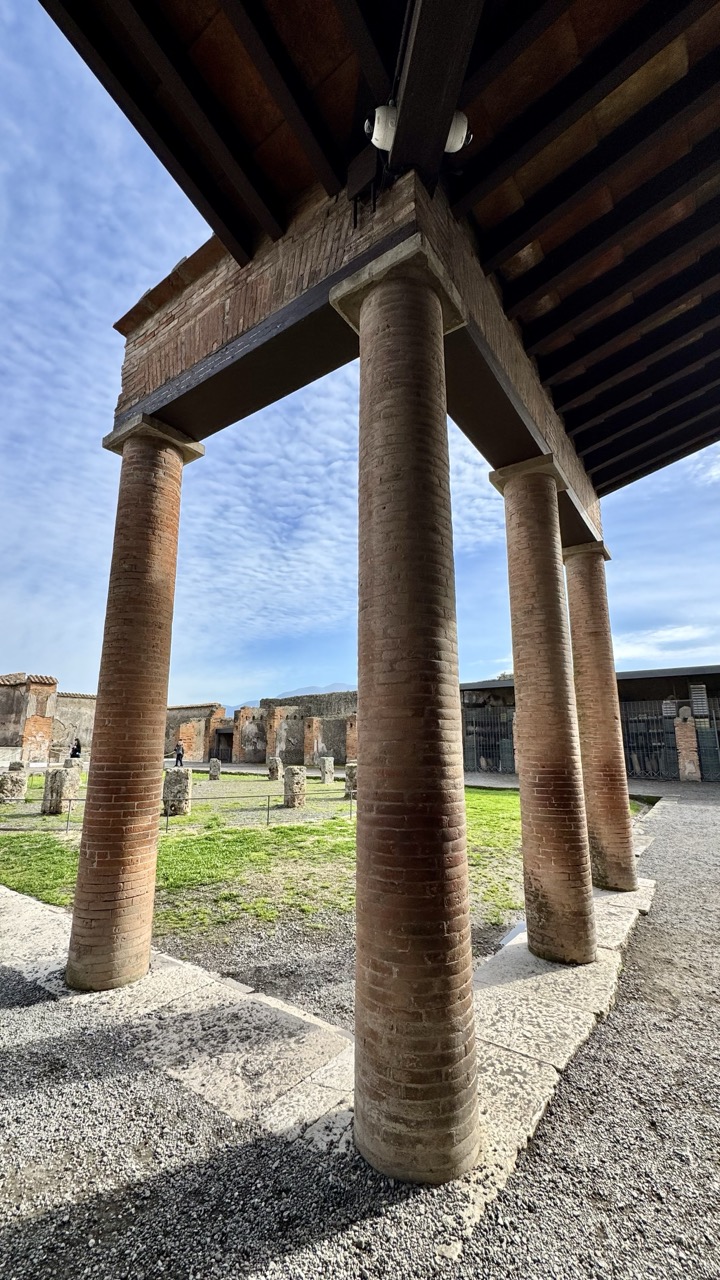

Colossal Columns and Cloudy Skies
Rating: 8/10
Talk about making an entrance! This shot is all about the imposing presence of these ancient, chunky brick pillars, demanding your attention front and center. They stand like stoic sentinels, framing a peek-a-boo view of distant ruins under a sky that looks ready for a dramatic historical reenactment, or perhaps just a mild afternoon shower. There's not much 'happening' beyond the quiet existence of time-worn structures, but the mood is definitely one of scale and history. It makes you feel small, in a good, 'wow, people built this ages ago' kind of way. The main subjects are undoubtedly these formidable pillars, the weathered pavement below, and the backdrop of archaeological remains, all tied together by a slightly dramatic sky.
From a photographer's perspective, this image uses a classic low-angle perspective to exaggerate the height and grandeur of the pillars, making them feel truly monumental. The composition employs strong vertical lines and natural framing, drawing the eye through the colonnade to the scene beyond. Lighting is a bit tricky here; the underside of the roof is quite dark, while the background is brighter, creating a challenging dynamic range. However, the light hitting the sides of the pillars beautifully highlights their rough brick texture. The color palette is dominated by earthy reds of the brick, the muted greys and browns of the ruins and ground, and the contrasting blue and white of the cloudy sky. It's effective travel or architectural photography, leaning into the power of structure and perspective to tell a story about the site's scale and history. You might argue the pillars are a *little* overwhelming, but that seems to be the point – they're ancient muscle, not delicate decoration!
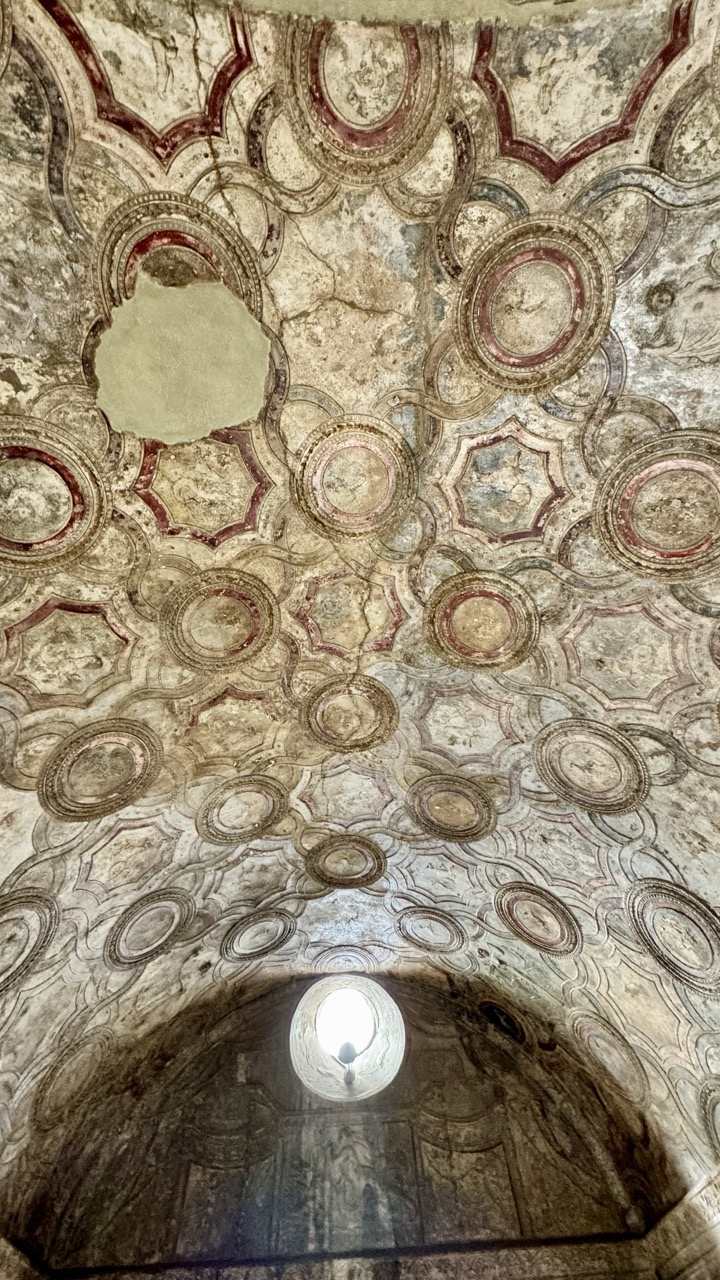

Vault of Vanished Splendor
Rating: 8/10
This image presents a captivating look upwards at a richly decorated but heavily decayed ceiling, earning it an 8/10 for its compelling subject matter. We are witnessing the slow surrender of an intricate fresco to the ravages of time; cracks trace weary paths across the plaster, and a large, irregular patch of modern repair disrupts the ancient pattern like an uninvited guest at a historical reenactment. The overall mood is one of venerable age and quiet deterioration, evoking thoughts of the countless events that have unfolded beneath this crumbling masterpiece over centuries. It's a powerful visual reminder that even grandeur eventually succumbs to entropy, leaving behind only whispers of its former glory etched in faded paint and broken plaster.
From a photographer's standpoint, the composition expertly utilizes a low angle looking directly up, emphasizing the vastness and complexity of the vaulted ceiling and its decorative scheme of interlocking circles and geometric shapes. The natural light streaming in from the circular oculus below draws the viewer's eye towards the base of the vault, creating a dramatic contrast with the more evenly, but dimly, lit upper ceiling areas, which highlights the textures of decay. The color palette is wonderfully muted and aged, dominated by earthy tones, faded reds, and outlines, perfectly reflecting the historical nature of the subject. While the composition successfully captures the impressive scale and detail (or lack thereof in places), that conspicuous repair patch is a bit of a photographic buzzkill, like finding a plastic spoon in an ancient artifact dig.
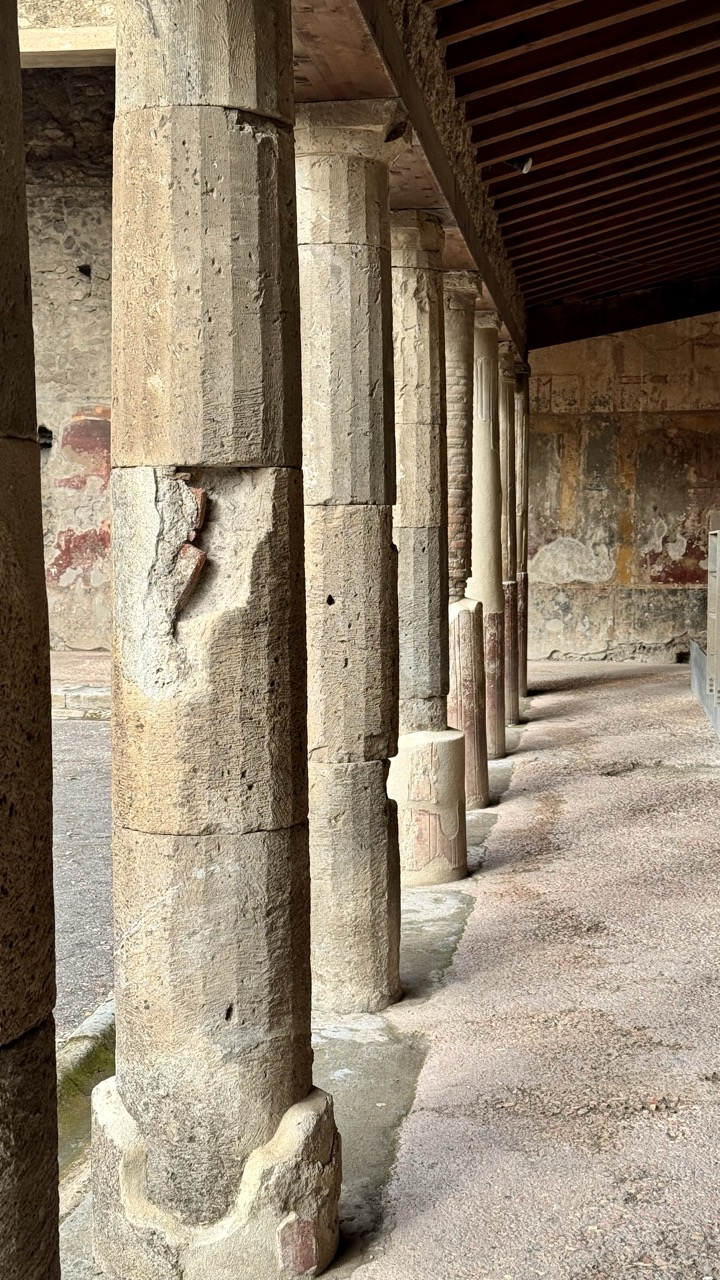

Pillars of Time
Rating: 8/10
Behold, a lineup of octagonal veterans standing stoically, proving that structure can outlast the party. This image captures a series of ancient stone columns supporting a weathered wooden roof, forming a covered walkway that whispers tales of centuries gone by. The mood is one of historical reverence mixed with the quiet solemnity of decay; these aren't just pillars, they're time capsules etched in stone. What's 'happening' is simply existence – a moment frozen, allowing us to appreciate the robust, if slightly battered, architecture. We see the rough, pockmarked texture of the stone up close on the leading column, gradually receding down the row. The background reveals faded frescoes on a wall, adding layers of past life to the scene, while the floor is a rough, textured surface leading the eye down the passage.
From a photographic standpoint, this is a solid architectural detail shot. The composition effectively uses the leading lines of the columns and the walkway to draw the viewer into the depth of the scene, even if the front column slightly dominates the frame. The natural lighting is soft, which is great for preserving detail without harsh shadows, though a bit more directional light might have enhanced the impressive textures and forms even further. The muted color palette perfectly suits the ancient subject matter, emphasizing the age and material without distraction. It’s a style focused on documentation and atmosphere, capturing the tangible presence of history. These old guys look like they could use a rest, or at least a good dusting, but they make for a compelling subject with incredible character.
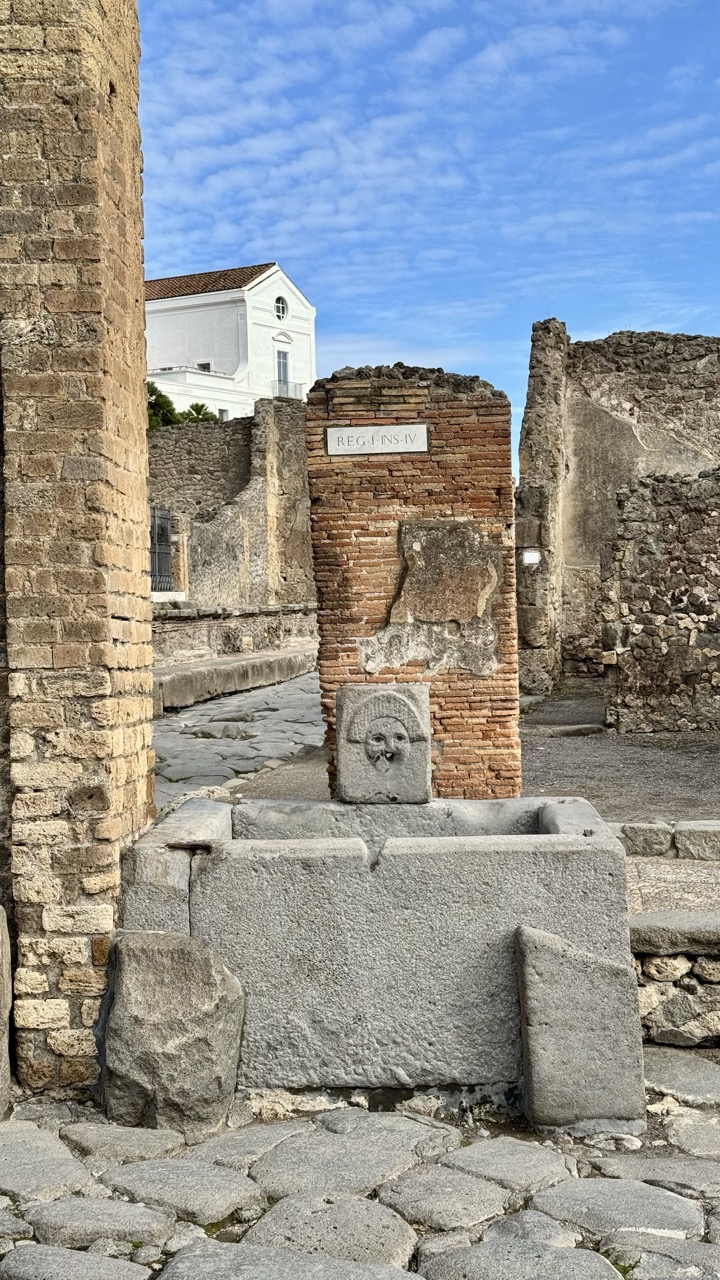

Ancient Waters, Modern Skies
Subject: 7/10
Step right up, folks, to the world's oldest public drinking fountain... probably! This shot transports us straight to the ancient streets of Pompeii, where history quite literally lies underfoot. The star of the show is this remarkably preserved stone fountain basin, overlooked by a brick wall proudly displaying the address tag "REG. I. INS. IV" – proving that even in antiquity, bureaucracy needed signage. Adding a touch of personality is the rather stern-looking carved stone face mounted on the wall behind the fountain, perhaps a silent guardian of the water supply or just having a really bad day for the last two millennia. The mood here is one of quiet reverence for the past, the crumbling stone and brick walls hinting at a once-bustling life, all set against a backdrop of a modern building peeking over the ruins and a lovely blue sky peppered with wispy clouds. The subject matter itself is a solid 7/10 for historical interest alone.
From a photography standpoint, the composition is straightforward, centering the fountain and using the flanking ruins as framing elements, though it feels a tad static. The vertical crop emphasizes the height of the walls and columns. Lighting is soft and even, which is great for showing detail in the textures of the ancient materials, but perhaps lacks the dramatic punch you'd get from stronger side light – no heroic shadows for our ancient face friend here. The color palette is dominated by warm earth tones, grounding the image in its historical context, while the bright sky adds a nice contrast and visual lift. It's a classic documentary style shot, capturing a key feature of the site. While not a groundbreaking composition, it effectively tells the story of the place, reminding us that even the most mundane elements of ancient life, like grabbing a drink, leave their mark on time. And honestly, that little carved face adds just the right amount of ancient meme energy.
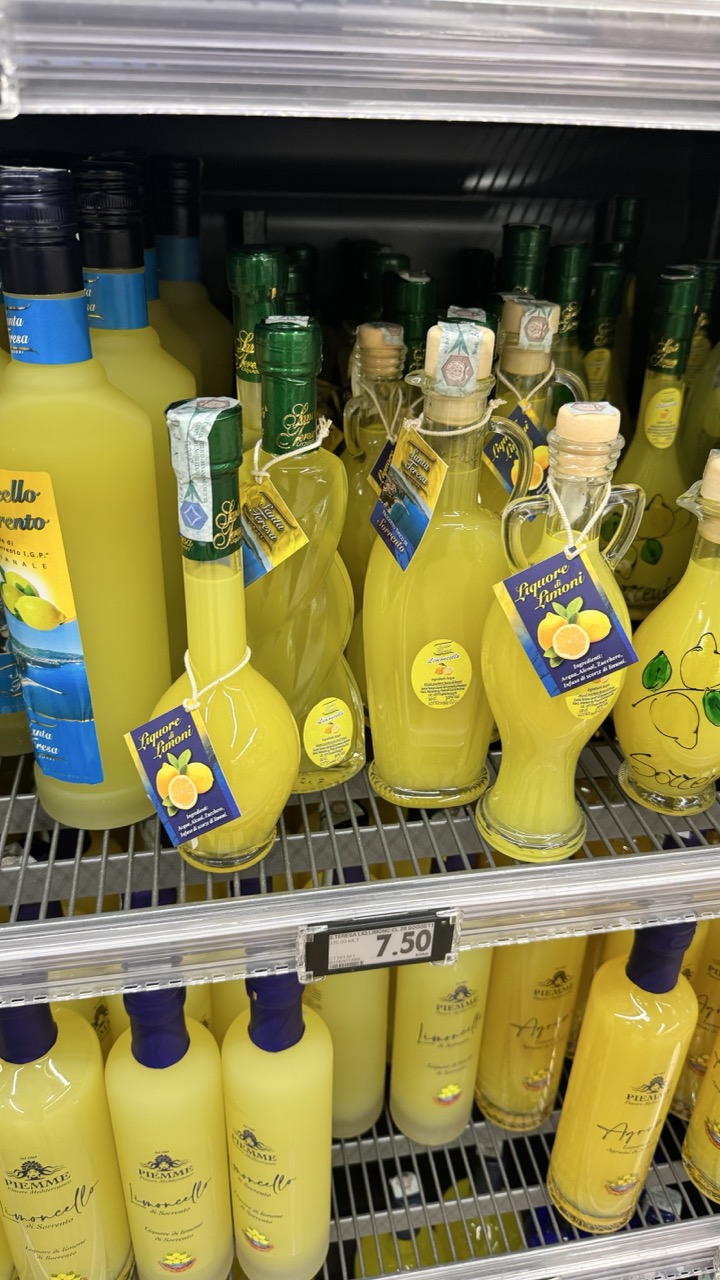

A Limoncello Lemonade Stand... Shelf.
Rating: 7/10
Welcome to the golden mile of Italian liquid sunshine! This image presents a vibrant display of Limoncello bottles, lined up on supermarket shelves like a dazzling yellow army ready for inspection. We see a variety of sizes and shapes, from tall standard bottles to charmingly small, uniquely contoured ones, each filled with the bright, opaque liqueur. Front and center, a price tag proudly declares one bottle costs €7.50, giving this sunny scene a touch of retail reality. The shelves themselves are standard wire grid affairs, holding their precious cargo securely, while the background recedes into a dark, non-descript void typical of supermarket aisles.
From a photographic standpoint, this is a very functional, almost documentary shot. The lighting is flat and even, courtesy of standard retail fluorescents, which unfortunately creates glare on the shiny bottles, obscuring some details. The composition is tight, focusing solely on the density of the product, emphasizing the sheer volume of Limoncello available. The strong horizontal lines of the shelves and vertical lines of the bottles create a somewhat rigid grid. While the vibrant yellow provides a cheerful pop of color, the overall execution is straightforward and lacking in depth or dynamic range. It's the kind of snapshot you take to remember a specific item rather than to create art, proving that sometimes, even the sunniest subject can look a bit ordinary under the harsh glare of retail lighting.
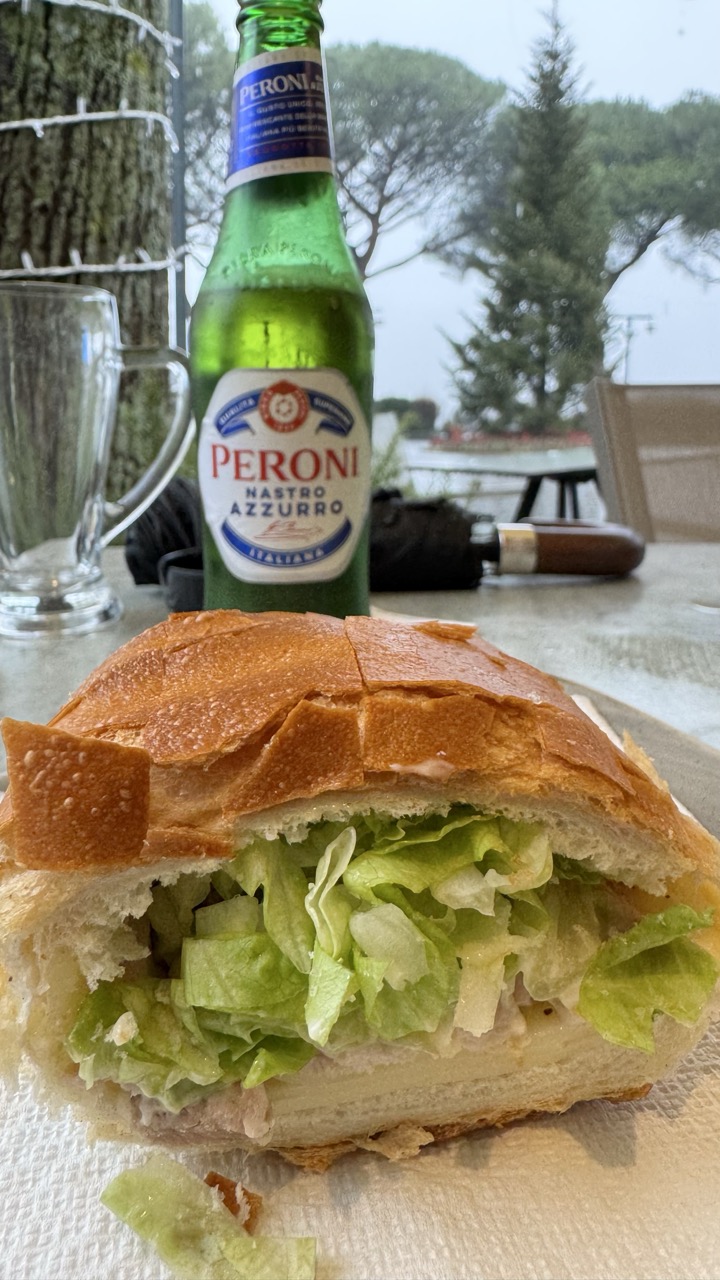

Lunch of Champions?
Rating: 7/10
Ah, the quintessential casual lunch setup: a robust-looking sandwich paired with a refreshing Peroni Nastro Azzurro. Front and center, a hefty sandwich stuffed generously with what appears to be ham and an abundance of crisp lettuce, sliced conveniently for easy consumption (or maybe just a dramatic reveal of the fillings). Sharing the frame, a cool green bottle of Italian beer stands guard behind the sandwich, promising refreshment. Off to the side, a sturdy glass mug awaits its pour, and a crumpled napkin suggests this isn't the first bite taken. The scene unfolds on what looks like an outdoor table, with a loosely draped string of lights around a nearby tree adding a touch of casual atmosphere to the slightly overcast, laid-back vibe of the meal.
From a photographic standpoint, this shot leans heavily into the "documentary snapshot" style. The composition is a bit off-kilter, with the sandwich slightly left and the beer bottle looming large but partially cropped, creating a sense of immediacy rather than careful framing. The shallow depth of field does a decent job of isolating the meal from the blurry background of trees and outdoor furniture, though perhaps a touch more of the beer label in focus would have been nice for the brand aficionados. Lighting appears to be natural and diffused, likely from an overcast sky, which results in soft shadows but can sometimes feel a little flat. While not a technically perfect or artistically groundbreaking composition, it effectively captures the simple pleasure of an outdoor lunch with a cold drink, making you almost hear the crunch of the lettuce and the condensation dripping from the bottle.
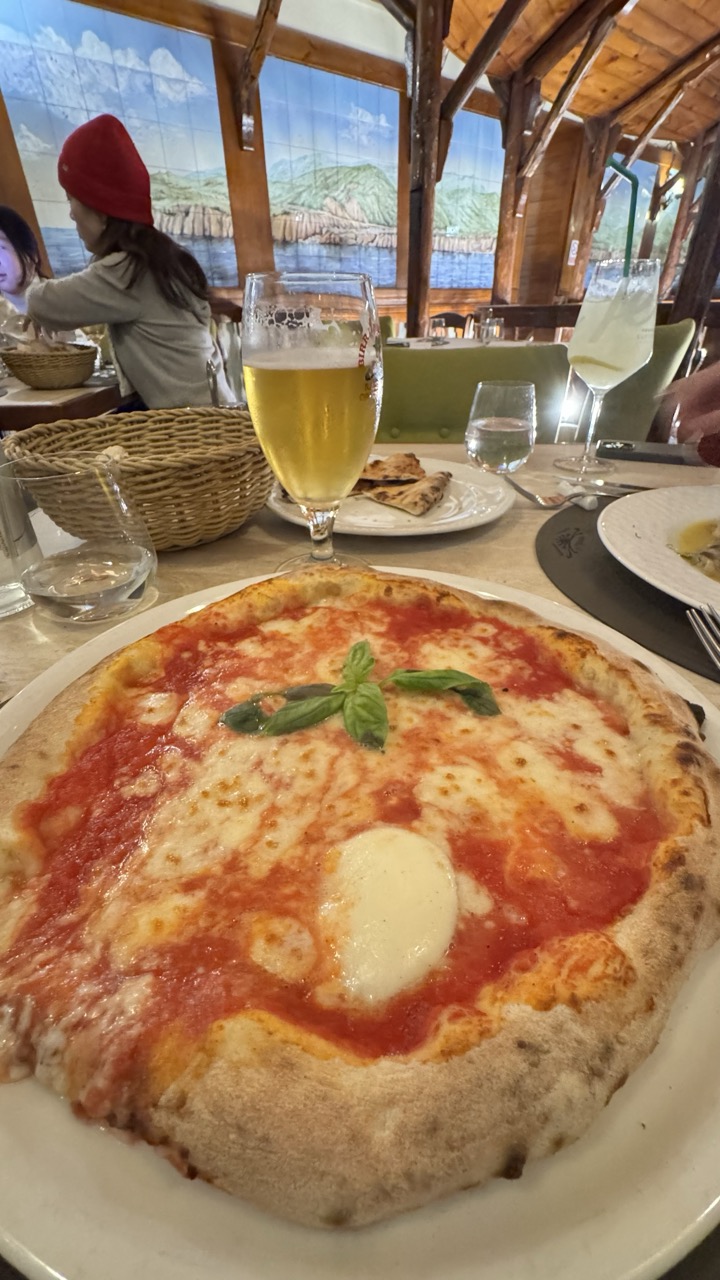

Title: The Foreground Feast and the Background Blues
Rating: 9/10 (for the pizza, obviously)
Alright, let's talk about this pizza. Gloriously centered and taking up roughly 70% of the frame, we have a textbook Margherita, looking absolutely delectable. The vibrant red of the tomato sauce pops against the melting white mozzarella and the verdant green of the basil leaves, promising a delicious bite. The crust appears perfectly proofed and baked, with that characteristic puff and slight charring. It's a hungry person's dream captured just before consumption. In the mid-ground, we see the supporting cast of a pleasant meal: a tall glass of golden beer with a nice head, another clear drink, and a rustic bread basket, all hinting at the relaxed, enjoyable mood of dining out. The perspective is very much "my table," giving a personal, almost impatient feel to the shot – clearly, eating was the priority over perfect framing.
From a photography perspective, this is the classic "document the food" snapshot. The composition is heavily weighted towards the bottom foreground, which, while showcasing the star, leaves the upper portion feeling a bit empty before hitting the busy background. Lighting appears to be a mix of ambient restaurant light, warm and inviting but causing some highlights on the drinks and pizza. The colors are rich and warm, enhancing the food's appeal. The background, while providing context of a restaurant interior with interesting painted murals of a landscape, is quite distracting. The angled beams and busy painting draw the eye away from the main subject and contribute to a slightly cluttered feel. It’s a casual, perhaps handheld phone shot, effectively conveying "I'm about to eat something great," but perhaps not winning any awards for compositional elegance or background control. Still, the pizza looks incredible, and sometimes, that's all that matters.
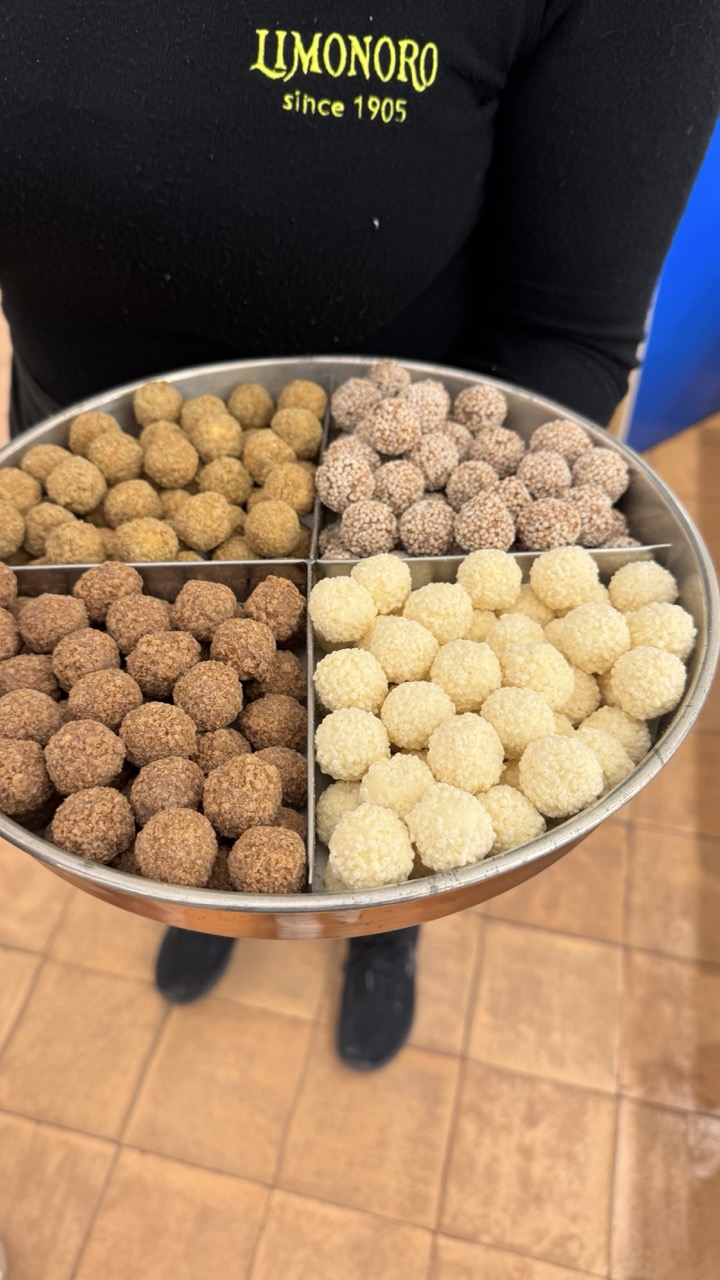

Sweet Offerings from Limonoro
Subject: 8/10
This image showcases a tempting tray of four distinct varieties of round, bite-sized treats, presumably chocolates or candies, held by a person wearing a black shirt emblazoned with the "LIMONORO since 1905" logo. The subject, these delightful-looking spheres of confectionery goodness, is undeniably appealing, presenting a colourful and textural array from light beige textured, to white coconut-like, to darker brown crumbly, and speckled brown varieties. The person's partial appearance emphasizes the delicious contents of the tray, creating an immediate focus on the edible bounty being presented, potentially for sale or sampling.
From a photographic perspective, the composition is... interesting. We get a great close-up of the goodies, which is the goal, but the person holding the tray is awkwardly framed, their head and arms mostly out of shot, creating a slightly disembodied, torso-centric presentation. The lighting is functional, illuminating the textures and colours of the candies adequately, though it lacks any dramatic flair or direction. The colour palette is dominated by the inviting warm tones of the candies and the black shirt, but the bright, jarring blue element in the background and the mundane tiled floor detract slightly from the otherwise appetising scene. It feels like a quick, informal snapshot designed to show off the product rather than a carefully composed piece of commercial photography – effective for teasing the tastebuds, perhaps less so for winning photo contests.
Loading map...